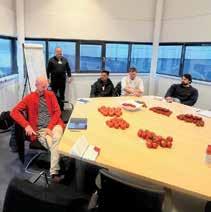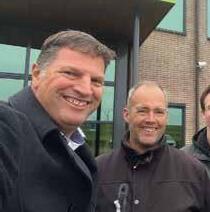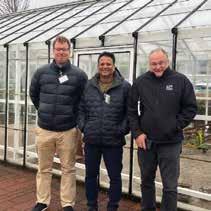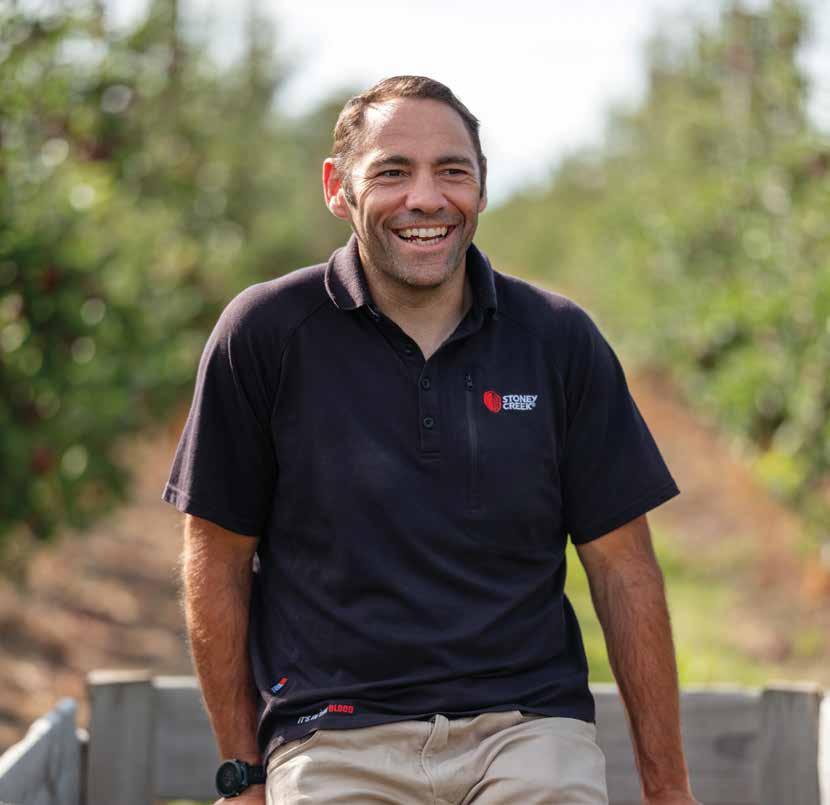
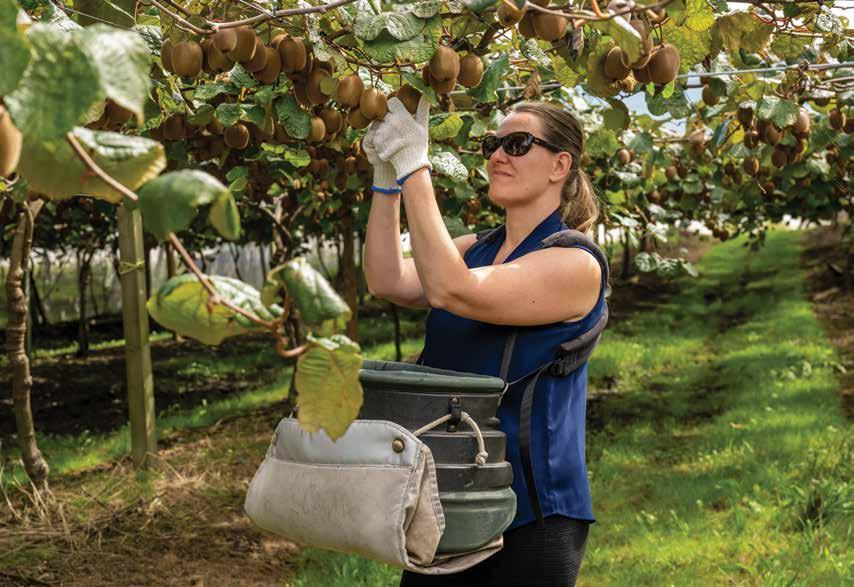



Do you or your team members want to develop new skills and knowledge in horticulture? Get in touch with Primary ITO today to find out more about training options for you and your business.
• Certificates and Apprenticeships
• Support and Funding Available
• Specialist training programmes in Fruit, Indoor and Outdoor Crop Production, Nursery, Post-Harvest and Distribution.
Talk to your local Training Adviser today: primaryito.ac.nz | 0800 20 80 20 | info@primaryito.ac.nz

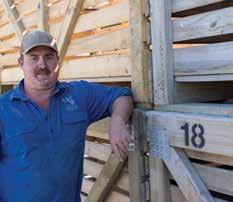
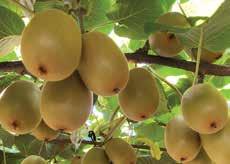
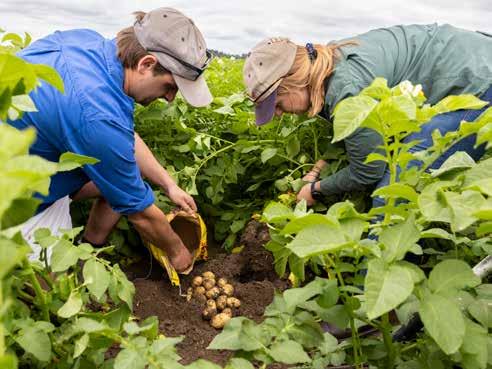
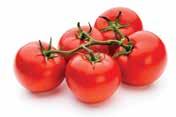
A regular advertorial section of new products and services. This publication does not endorse the products or services featured here.
61 Genesis Nurseries: Chris Hurrey Brings Expertise to Genesis Nurseries as Head of Operations
Con Williams is Craigmore’s general manager horticulture, overseeing its growth into one of New Zealand’s largest apple growers. Read more on page 5. Photo by Florence Charvin.
This will be the last article I will write as Chairman and President of Horticulture New Zealand, as I step down as Chair and also as a Director of the board at the end of this month.
By Barry O’Neil : HortNZ chair
It has been an absolute honour for me to be a director on the HortNZ board, and I would like to thank growers for supporting me in being elected to the board, and for my fellow board directors in having confidence in me to appoint me as their chairman.
Horticulture is such an important and growing business for Aotearoa New Zealand and its people. And while I have a dream of horticulture one day being bigger than dairy it couldn’t happen on my watch, but we are now at number three, a long way behind dairy but only just behind red meat. Reaching for the stars –and if you only get to the moon it is still bloody good in my book!
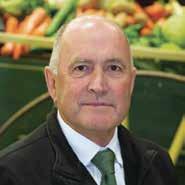
Working together with Product Groups, District Associations and growers I think we have done an incredible job navigating through these challenges and getting the best results we can for growers and growing.
But there is also important unfinished business, and one area that has taken far too long to agree on is how we can and will work even better together in the future, to deliver greater value for our growers, and I encourage all involved to land this and then get on and make it happen.
The highlights for me – working with the fantastic team at HortNZ who always go out of their way to deliver the best outcomes that can be achieved for growers. Growers are at the core of HortNZ as they should be, and I have very much appreciated and enjoyed the engagement and friendships that have developed over my time on the board. I believe the strong support we achieved in renewing our Commodity Levy reflects the value that HortNZ has and is delivering to growers and growing, and I would especially like to acknowledge and thank the three amazing chief executives who have led the organisation and who I have really enjoyed working with: Mike Chapman, Nadine Tunley, and now Kate Scott.
The lowlight, when people don’t see the value of working together, and want to go off and do their own thing believing this will result in a better deal for them. Maybe it does sometimes, but history usually shows we are always so much stronger and get better results when we work together.
Lots of achievements while I have been on the board, as well as some huge challenges, have been worked through. Cyclone Gabrielle, Covid-19, closed borders, shortage of labour and Recognised Seasonal Employer scheme workers, climate change and emissions reductions, high input costs and low returns, Resource Management Act reforms, etc.
Barry’s truisms of what we are dealing with when it comes to how we need to work together: Government doesn’t want to work with 21 different horticulture industry good groups and expects HortNZ to take and show leadership on national policy issues. It’s just too easy for government to divide and conquer us if we are fragmented.
Nothing in life is free, but 14 cents HortNZ levy per $100 of sales for every type of grower is insignificant. Yes, it adds up, and yes while a kiwifruit grower pays no more levy than a carrot grower, kiwifruit is the biggest contributor to our levy. I believe HortNZ has contributed to kiwifruit’s success and so as a kiwifruit grower I see this as the price of success.
Collaboration isn’t about saving money, but about achieving scale and taking out duplication to deliver greater value for growers’ dollars. Growers must always be at the centre of our conversations and decisions, and we should not be precious about organisations that have been created to serve growers and growing.
Collaboration won’t work if there isn’t trust, and endless process will always take over if there isn’t clarity of leadership due to lack of trust. HortNZ has been tasked to take leadership, not avoid the hard issues, and to strongly advocate and influence for grower success – which it has been doing – but how we have to work currently is consuming too much staff effort and time.
Busy growers often don’t engage unless they are very involved in an issue, so we always need to be careful that the minority who do engage are not lobbying their hobby horse, and as a result they don’t overly influence the outcome when the silent majority have a different perspective.
Change is constant and organisations and businesses must adapt and evolve if they are to stay relevant. While it hasn’t been without its pain, HortNZ is now a better and stronger organisation as a result of the modernisation process we have been in for the last five years.
I’ve written too many of these being over ten years on the board, and coming up to six years as chair, so thanks for your tolerance and perseverance! As I have written before, this length of time is more than long enough in these leadership and governance roles, and it’s time for new energy and ideas.
I strongly believe we will be bigger than meat in the not-too-distant future, and look out dairy!
My best wishes to Bernadine and Brydon, as incoming chair and deputy, and to the future board. I believe we are in good hands to lead us in the challenges ahead, and I am also really pleased that I am stepping down with Kate as our chief executive, along with the great leadership team in HortNZ. Thanks once again for your support and wise counsel as we have strived to create an enduring environment where growers can thrive. And lastly, I strongly believe we will be bigger than meat in the not-too-distant future, and look out dairy!
Enjoy growing and be careful out there. Kia kaha.
AROUND THE TABLE WITH GOVERNMENT
NZGrower & Orchardist sat down with Barry to reflect how working both for and with government has shaped his career. Read the interview on page 30.
Confirm your order today for the upcoming planting season.
Our budding season’s fast approaching and the window to get your orders in is closing soon! If you need top-quality trees for the upcoming planting season, now’s the time to secure them.
With expert techniques and premium rootstock, we ensure strong, healthy trees ready to thrive. Don’t miss out! Place your order today.
We still have a limited number of trees available for 2025 deliveryget in touch today to secure yours!
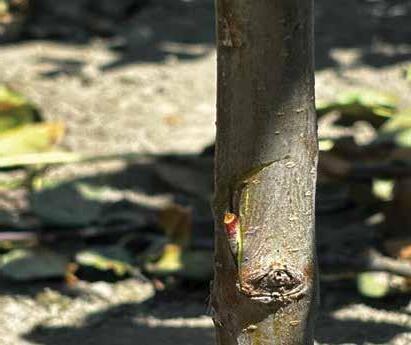
NZGrower & Orchardist is produced by Horticulture New Zealand and is free for all levy payers. The magazine is partially funded by a grant from the NZ Fruitgrowers’ Charitable Trust to ensure all fruit growers in New Zealand receive a copy each month. The magazine is also supported by Vegetables NZ, Process Vegetables NZ, TomatoesNZ, Potatoes NZ and Onions NZ.
The individual comments and views in this magazine do not necessarily represent the view of Horticulture New Zealand.
Copyright © 2025
NZGrower & Orchardist
NZGrower & Orchardist:
ISSN: 3021-3606 (Print) ISSN: 3021-3614 (Online)
Editor: John Gauldie, editor@hortnz.co.nz
Advertising Manager: Debbie Pascoe, 027 485 8562 debbie.pascoe@hortnz.co.nz
Design:
Scenario.co.nz, 04 385 9766, joy@scenario.co.nz
Subscriptions: subs@hortnz.co.nz
This publication uses vegetable-based inks and environmentally responsible paper produced from Forest Stewardship Council® (FSC®) certified, Mixed Source pulp from Responsible Sources.
Paper produced using Elemental Chlorine Free (ECF) and manufactured under the strict ISO14001 Environmental Management System.
The wrapper we use is 100 percent recyclable, it is LDPE 4 (Low Density Polyethylene) Soft Plastic and meets the required standards. For further information refer to: www.recycling.kiwi.nz/our-story
Kia ora koutou,
The 2025 Horticulture New Zealand Conference is set for 26–27 August in Wellington.
It’s an opportunity for growers, industry leaders, and policymakers to come together and shape the future of our sector.
We’re looking forward to updating growers on how we’re working to ensure horticulture remains central to New Zealand’s economy and food security.
• simplifying assurance processes
• aligning education with industry needs
• providing certainty for the Recognised Seasonal Employer (RSE) scheme.

Our industry is key to building a sustainable economy – delivering high-quality, nutritious food while supporting jobs, exports, environmental stewardship and communities.
The Aotearoa Horticulture Action Plan – a partnership between industry, government, Māori, and science –aims to double our farmgate value by 2035. Achieving this goal will require strong collaboration and smart policy.
In 2025–26, we are focused on six priorities:
• securing reliable water access
• ensuring affordable and healthy local produce
• enabling access to new pest management tools
Water security is crucial for high-quality crops, and while the government’s Fasttrack Approvals Act is a start, broader catchment-focused solutions are needed. At the same time, simplifying regulations around vegetable growing and ensuring fair supermarket pricing structures will support both growers and consumers.
Our growers also need access to new technology, streamlined assurance processes and a skilled workforce to thrive. Securing certainty for Pacific workers under the Recognised Seasonal Employer (RSE) scheme is equally vital.
The right policy settings will give our growers the confidence to invest and innovate. With targeted support, we can boost exports, strengthen food security and ensure every New Zealander has access to fresh, nutritious fruit and vegetables.
Ngā
mihi
Kate Scott, HortNZ
chief executive
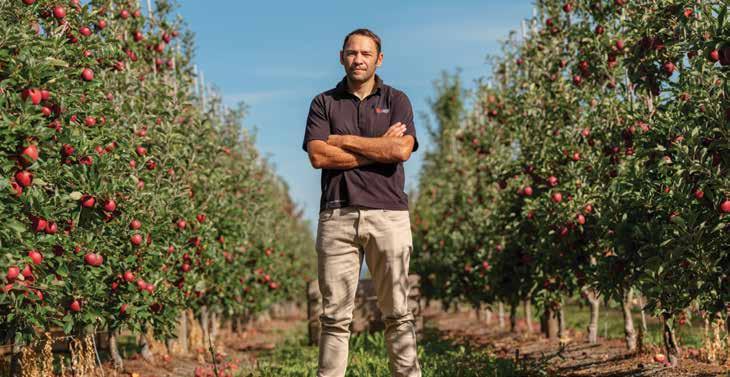
Capital inflows from a raft of recent investments by Craigmore Sustainables are helping to recapitalise New Zealand’s overstretched pipfruit industry. For Con Williams, general manager horticulture at Craigmore, the challenge now is to deliver results.
John Gauldie
Photos by Florence Charvin
Two years since his appointment to Craigmore’s leadership team, Con Williams is overseeing the company’s largest ever harvest. He has responsibility both operationally and commercially for 22 mostly apple, kiwifruit and grape growing sites in Kerikeri, Bay of Plenty, Gisborne, Hawke’s Bay, Marlborough and Nelson.
Craigmore’s horticulture portfolio comprises more than 2000ha. Over the last year Craigmore has acquired four apple orchards totalling 335cha (canopy hectares), plus two new Marlborough vineyards and a new 48cha kiwifruit orchard in Pongakawa. The property purchases and associated redevelopment investments will total more than $250 million.
“Several of those properties have settled in the last four to five months,” Con says. “So there’s been a lot of work around bedding them in. The capital that we’re bringing in is rejuvenating some of the older areas of those orchards. That will be ongoing for the next 18 months to two years.
“When it’s fully developed, we’ll have about 720ha in apples. We’ve got quite a big growth curve there and within a few years’ time we’ll be one of the biggest apple growers in New Zealand.”
Horticulture has grown into the largest arm of Craigmore’s $1.1 billion portfolio of farmland, forestry and cropping. The company, established in 2009, manages institutional investments owned mostly by international clients.

Craigmore is developing its own apple growing teams in Central Hawke’s Bay, Gisborne and the Heretaunga Plains
Craigmore provides governance and management services, with a high level of local operational control.
Given the investor-focused commercial, governance and reporting aspects of his role, in addition to the operational oversight, it’s not surprising that Con has had an interesting pathway into horticulture.
With a family background in livestock farming in Central Hawke’s Bay, Con studied at Massey University before starting as an economist for Beef + Lamb NZ. After that he spent eight years on the trading floor at ANZ Bank as rural economist. From there he moved to MyFarm Investments where he was responsible for capital raising and the endto-end process of establishing commercial syndicates.
He began at Craigmore just before Cyclone Gabrielle hit. “There were some challenges coming out of that. A steep learning curve obviously. For me it’s a bit more hands-on in terms of operating – the nice thing is the deep experience we’ve got within Craigmore and with our partners in growing the individual crops and developing orchards.”
He leads Craigmore’s team of horticulture business managers, including Ben James for apples, Emma Taylor for viticulture, Alan Dobbie for kiwifruit and Shane Flynn for developments.
Craigmore’s main focus is on creating value up to the orchard gate by investing in high performing teams, premium varieties and creating leading assets through redevelopment into modern growing systems. The company has different business structures for managing its portfolio – for example Craigmore partners
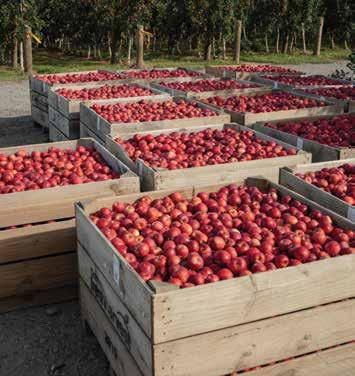
At its many apple orchards, the company grows a large variety mix, and recently acquired a 33 percent stake in Fruitcraft
with Indevin for its 170cha grape growing in Central Hawke’s Bay and with Babich Wines at its 200cha Cat Creek vineyard development in Marlborough.
Third party orchard management is well established in kiwifruit – Craigmore works with EHC Orchard Management in the Bay of Plenty and Seeka in Northland.
Horticulture has grown into the largest arm of Craigmore’s $1.1 billion portfolio of farmland, forestry and cropping
However, third party management is not a structure that is readily available in pipfruit. Craigmore is developing its own apple growing teams in Gisborne and Central Hawke’s Bay – and soon turning to the Heretaunga Plains where its three orchards are currently leased or on short-term management agreements.
“We’ve got a staged implementation plan around taking over the management of those properties longer term. So that’s probably two seasons away.”
Another notable recent acquisition is a 33 percent stake in Fruitcraft, taking over from Kiwi Crunch as one of the three grower partners.
“One of our big challenges in apples is what variety to plant. That’s so fundamental. If you get caught with the wrong variety mix, it will be quite expensive to change.
Central Hawke’s Bay
Springhill Orchard
• 180cha apples (plus 170cha grapes)
Te Papa Orchard
• 107cha apples
Heretaunga Plains CFP
• 98cha apples
Blyth Orchard
• 96cha apples
Ngaruroro Orchard
• 67cha apples
Gisborne
Sunpark Orchard
• 45cha apples
Glenpark Orchard
• 33cha apples (plus 8ha grapes)
Patutahi Orchard
• 49cha apples (plus further 16cha to be developed in 2025)
Northland 120cha
• including some avocados
Bay of Plenty 110cha
In addition to its apple and kiwifruit orchards, Craigmore’s horticulture arm also operates a number of vineyards as well as hops and other growing operations on both the North and South Islands
“We see [acquiring Fruitcraft] as a good opportunity for us to be quite close to those decisions, partnering with people with established access to this IP (Intellectual Property) and those further up the supply chains with good market penetration and solid sale platforms into the main retail and wholesale channels in major markets. We’re making sure we’ve got access to the right varieties when we need it to redevelop these orchards.”
Nevertheless, even with properties planted with the right varieties, Con says everything always comes back to the performance. And as he is keen to stress, bigger isn’t always better.
“Productivity is paramount to navigating the difficult business environment that we’re in. You’ve had a structural lift in the cost of production and wages in New Zealand and the only way we’re going to get profitable businesses come through and lift wages again is in productivity gains. It’s not necessarily growing more fruit per se, but maybe it’s how to reduce your cost of production and grow the same amount of fruit so you increase your operating margins.


“We’ve created quite a big footprint in apples, but we’re still quite young as a horticultural business when you actually reflect on the number of commercial harvests that we’ve done. It’s important to be able to grow your footprint in a credible way by building the supporting infrastructure and the skill base that you need.
“Because we’ve expanded so quickly, we can’t just step out into the market and employ a lot of experienced orchard managers – you’ll probably annoy everybody else if you do that. So building a base of skilled and experienced people to look after the orchards has been quite a big focus for Craigmore.
“That’s part of what Ben James is doing, creating that team that is very good at growing commercial crops. And we’ve made great progress in recent years around that. And certainly, developing our own people internally and seeing them progress quite rapidly, it’s rewarding.”


& Kelli Cooke, 75 York Road, Longlands, Hastings 06 870 7043 • 0274 396 205 • lecooke@xtra.co.nz www.lecooke.co.nz

Craigmore operates 465ha in Central Hawke’s Bay – including its flagship Springhill apple orchard and vineyard, plus its recent acquisition of Te Papa Orchard.
At Springhill, a greenfield conversion from grazing land in the Ruataniwha Basin, planting began in 2019 and finished last year. A larger proportion of the 350ha canopy is under netting, providing protection from hail which can occur in this location closer to the ranges.
“Springhill has been quite an investment,” says Con Williams, Craigmore’s general manager horticulture.
“The change you see when you roll down the road and then see this high-density spindle orchard with full cover over the top of it, it’s significant.
“This is our third commercial apple harvest, but we’ve still got a lot of young trees. We did about 11,500 bins last year and forecast to do about 17,000 this year.
“The early productivity indicators show we’re hitting our yield for grapes and apples. It looks really positive and exciting. That comes down to the biophysical nature of those soils and the climate, combined with the management and obviously the orchard set-up.”
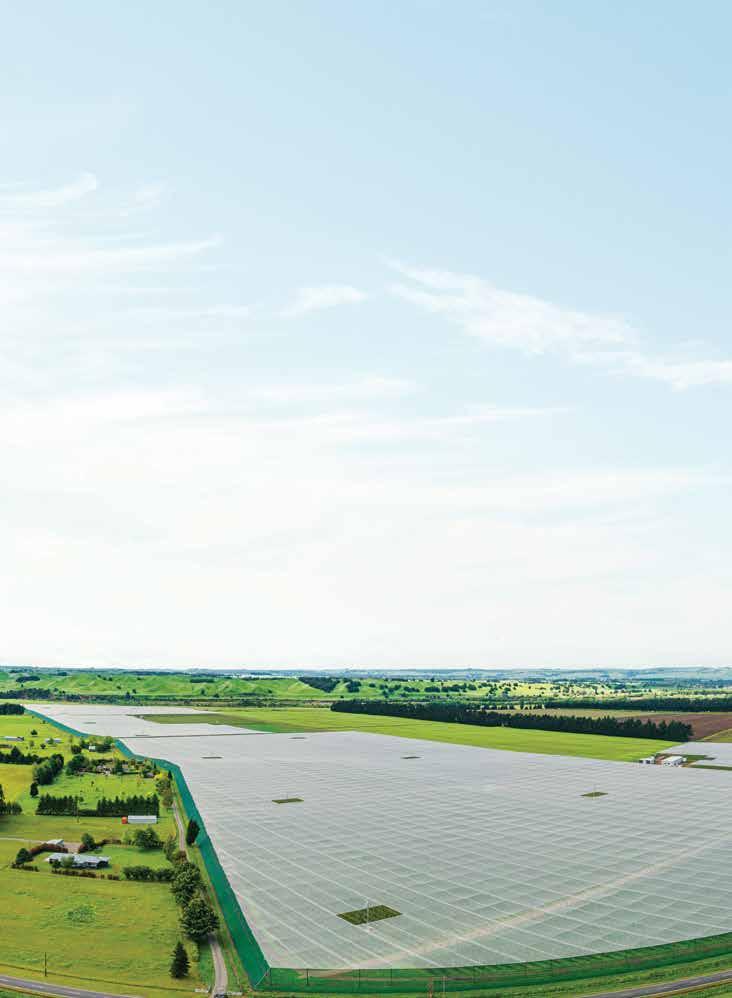
Although apples began establishing in the Ruataniwha Basin in the 1980s, development has been limited due to the cooler climate and additional running costs for transport – not to mention water storage. Land prices are significantly cheaper than the Heretaunga Plains, which makes a marked difference in initial investments and creates a possible development margin.
“It’s proving to be quite a good growing area and possibly improving with climate change. But with climate change, there’s obviously going to be a bit more volatility. So we’ll have to manage for that.”
Other orchards in the Ruataniwha Basin include Mr Apple’s Kanuka, Hampden and Rangihau (157ha), Mr Apple’s Pacific and Thornton (186ha) and the 62ha Gold Water (which Bostock sold to Dutch wealth managers Van Lanschot Kempen last year).
Craigmore’s new Te Papa Orchard, which is five minutes down the road from Springhill, is a wellestablished orchard with a mixture of modern growing systems and older 3D trees. The shortterm management agreement with Mr Apple will complete at the end of next season.
Craigmore is currently undertaking some significant redevelopment.
Craigmore has several initiatives to attract young people to horticulture and hire locally, including sponsoring the Young Grower of the Year regional contests and supporting the national competition.
Craigmore has become an accredited Recognised Seasonal Employer and is building that side of its capability too. With last year’s acquisition of Te Papa Orchard in the Ruataniwha Basin, Craigmore has also acquired accommodation with 148 beds.
There are likely to be more acquisitions involving foreign capital in the future. Con says there is plenty of overseas appetite for horticulture investment in New Zealand.
“I think one dynamic of the falling New Zealand dollar that people don’t quite appreciate, is that it’s actually quite a good time if you’re a US dollar investor to invest in New Zealand.
“We’ve also had a change of government and it’s looking for new capital to grow the economy and New Zealand business. There’s definitely been a different direction from the government to the Overseas Investment Office.
“If New Zealand wants to grow its economy and business sector it needs more risk capital, and some of that has got to be foreign investment.”






















“If New Zealand wants to grow its economy and business sector it needs more risk capital, and some of that has got to be foreign investment”
Con Williams
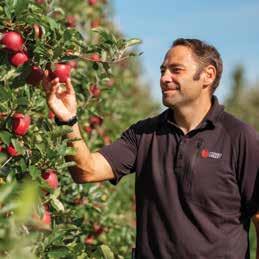
Exchange rates are also set to benefit orchard gate returns as exports ramp up this year.
“Particularly for apples and kiwifruit, early season returns are looking positive, the market’s pretty good at the moment, so I’m hoping that the sectors won’t trade too much away on price so we see those [currency margins] back at the orchard gate.”






















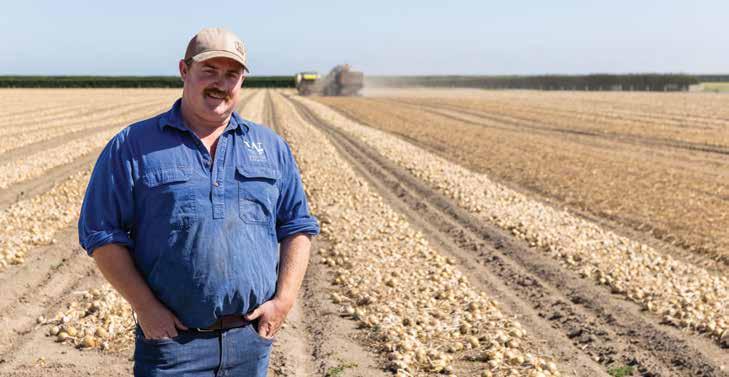
Growing onions throws up a new challenge every season, says Tom Webster, whose family has been growing the crop in Canterbury for six years and this year plans to harvest 5500 tonnes from 90ha.
Tony Benny
“I don’t know if there is a perfect place to grow onions. We’ve been getting good solid results here but the whole thing with onions is they’re a challenge,” Tom says.
Tom farms in partnership with his brother George and parents Peter and Nicky. They have 800ha, including a lease block in Kirwee, west of Christchurch, and 650ha in Dorie, about 30 minutes away.
They previously had a dairy farm and grew arable crops, grass seed, carrot seed and various other vegetable seed crops but when they had the opportunity to buy into Southern Packers, a Timaru onion packing, processing and exporting business, they planted onions, too.
The packhouse began with Alpine Fresh (the Howey family) and the following year the Pye, Turley and Howey families together with Scales Corporation joined to form Southern Packers. Since then Scales have sold out, the Hewson family has bought in and most recently the Webster family has bought out the Howey family.
“We were very fortunate the Turleys, Pyes and Hewsons let us come on board. They’ve all been a great help, getting us started and mentoring us into vegetables,” says Tom.
Their first season was “phenomenal”, says Tom, thanks to a shortage of onions in Europe lifting demand and prices. Since then there’s been Covid-19 and all the disruption that caused along with changes in the international markets that 85 percent of New Zealand onions are exported to.
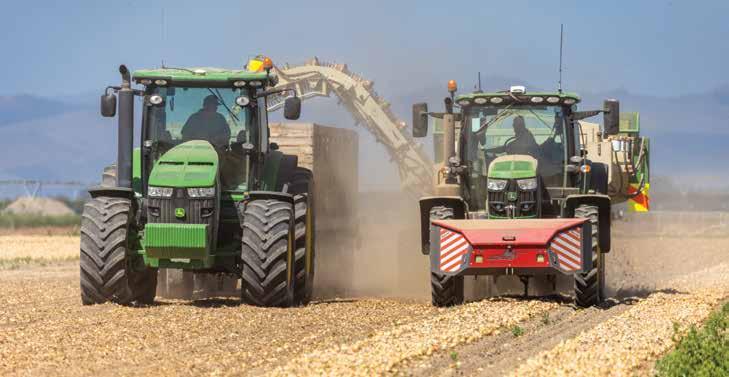
This year’s summer has been cooler but the onion harvest is looking good
“We’ve also had shortages of seed varieties where we made some silly decisions and went too heavy with new varieties that we didn’t know and that came with a huge cost to quality,” Tom adds.
Their first season was “phenomenal”, thanks to a shortage of onions in Europe lifting demand and prices
“Every year comes with its challenges with onions unfortunately. Shipping is the big one this year because
ships seem less willing to come to New Zealand and this, along with security issues around the Suez Canal, is adding a lot of pressure and added expenses.
“Next year we’re again faced with seed variety shortages with one of our key varieties Rhinestone completely out.”
Despite his concerns, Tom says the crop is looking good even though this year’s cooler summer in Canterbury hasn’t been perfect for the arable harvest.
“Good crops, along with tariffs coming off in Europe and agreements reached with Indonesia meaning no fumigation is required, have put us in a lot better position than last year.
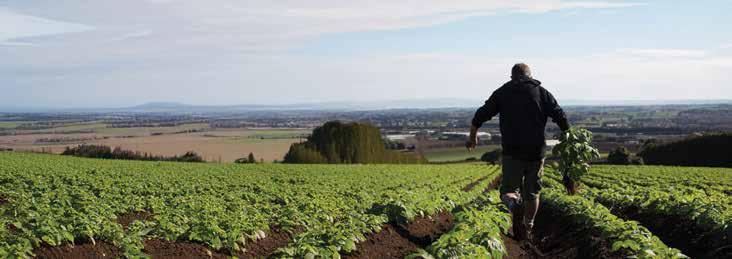

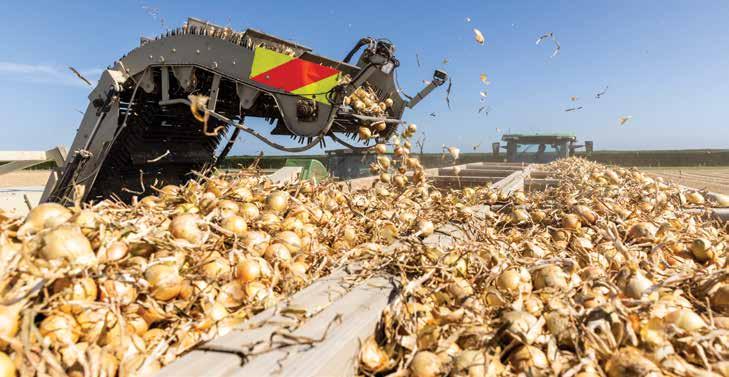
“We want it not too hot and not too cold. This season’s been quite challenging for our arable harvest but with the higher humidity and the temperatures not getting as high, the skin quality appears to be quite good at the moment.
“The packhouse will tell the real story. They’ve got an optical grader that does internal and external photos.
“They never get any better than they look in the paddock, it only gets worse. Getting it wrong is where the real risk is, getting a container arriving that’s poor quality is very expensive for us, very expensive for everybody.”
The challenges of onion growing in Canterbury start at the very beginning. After the ground has been reverse rotary hoed to bury any stones and condition the soil, the onion seed is precision planted.
“The first risk is wind and erosion so we plant across from the Nor’wester and have a cover crop of wheat or something similar that we broadcast on in front of the planter and later spray out.
“That helps with the issue of wind and the next challenge is weed control which is somewhat of a recipe but onions are challenging in terms of herbicides a little and often – you can hurt them – and then there’s disease.”
They grow onions on both farms, along with potatoes, for rotation and the geographical spread for risk, as well as carrot seed, grass seed, wheat, barley, clover, peas, pak choi, sunflowers, radish for seed production and greenfeed crops such as oats, rye-corn and rape for wintering dairy cows and trading store lambs.
The family also has a dairy farm at Dorie which occupies half the land there, run by a lower order sharemilker. Finishing store lambs is the livestock focus at Kirwee, both for the income that generates and as an essential part of the grass seed business. The first of those arrives as harvest gets underway.
The farm at Kirwee, where Tom lives, is irrigated by bore water that supplies a third of requirements and the remainder comes from the giant Central Plains Water (CPW) scheme that draws water from the Rakaia River and distributes it over 45,000ha of central Canterbury.
The onions are harvested into open bins and finish curing in an open store before being trucked to the packhouse in Timaru, about 130km away
“CPW works exceptionally well and having the pressurised water to the gate is so simple. You don’t need pumps so although it’s expensive, you’re getting a quality outcome out of it,” Tom says.
An added advantage of being part of the scheme is that CPW assists with farm environmental plans that make complying with environmental regulations and constraints as easy as possible.
With the onion harvest coinciding with other crops coming in, late summer is a very busy time on the two farms.

Tom says the Central Plains Water scheme works exceptionally well
1/3 BORE WATER 2/3 CENTRAL PLAINS WATER SCHEME
The onions are harvested into open bins and finish curing in an open store before being trucked to the packhouse in Timaru, about 130km away.
“We’re the furthest north for Southern Packers and we’re the furthest north for McCains so transport is a very real thing but hopefully in time roads and trucking will get more efficient, I would have thought. We are fortunate because we are allowed heavy loads on trucks in New Zealand.”
While growing onions does come with challenges, Tom is sure the family business is on the right track, diversifying and expanding as opportunities arise. “My parents have always had a diverse business model and as George and I have become more involved, the onions and the spuds have come into it as well.”
While he’s unsure exactly what climate change will deliver to the region he’s confident their good soils and irrigation have them ready to take on future opportunities too.
“Canterbury has a relatively temperate climate and we have the ability to pivot our production,” he says.
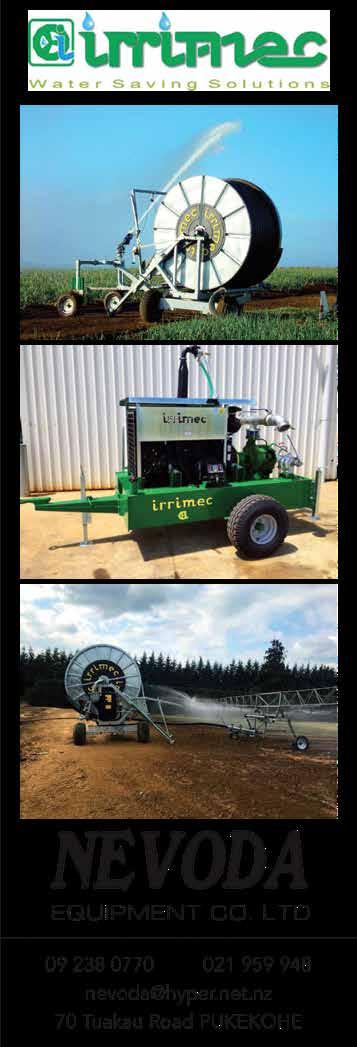
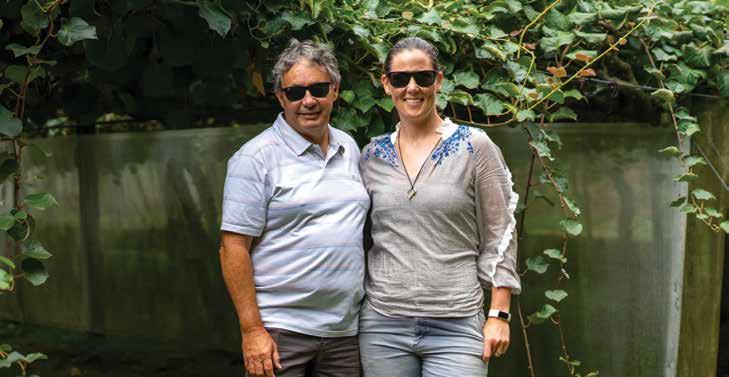
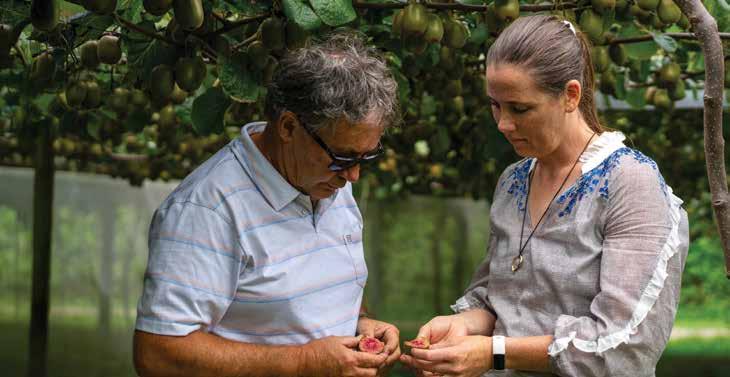
John and Liarna White have been growing Red19 since an early trial in 2016 at their Ōpōtiki orchard
Testing out the new kiwifruit variety Zespri RubyRed TM has been more of a ‘trial by flood’ than ‘trial by fire’ for growers John and Liarna White, but they say calmer waters are ahead.
Kristine Walsh
It has been 50 years since the late Dave and June White planted kiwifruit on their 12ha block, elevated above the gleaming waters off Ōpōtiki’s iconic Waiotahi Beach.
In the decades since, their son John – and now his wife Liarna – have developed a pretty well-stacked toolbox to deal with challenges and developments in the industry. And it’s one they readily crack open to tinker with elements like new varieties, of which they are keen triallists.
One of those varieties is RubyRed (Red19) – developed by the Zespri and Plant & Food Research Kiwifruit Breeding Centre joint venture – of which the Whites established an early (2016) trial of 0.28ha grafted on Green at their Ōpōtiki orchard.
That area has since grown to 0.84ha and over to the east, they have installed 2.28ha of RubyRed (also grafted on Green) on one of their two Gisborne blocks.
In terms of production, the early RubyRed at Ōpōtiki is heading for its sixth harvest while the newer plantings –at both Ōpōtiki and Gisborne – make their debut this year.
And while the couple admit their work with the new variety has come with plenty of challenges – and a big bunch of learnings – they’re optimistic the 2025 harvest will deliver good-sized, great-quality fruit that will be welcomed on the global market.
If anyone could have brought the new red variety to that space throughout some trying (read: weather) times, it’s the Whites.
Both bring academic degrees to their work – John in Horticultural Science, and Liarna in Applied Science (Horticulture) – along with decades of on-orchard work, governance and, in John’s case, five years as technical manager (new varieties) with Zespri.
Now, as well as raising their three children, both are zeroed-in on the three orchards managed by their Jolarna Trustee Company with a focus on improvement for their own properties and for growers across the country.
“There have been red ‘starburst’ kiwifruit on the market but the new solid red is an exciting variety and we believe strongly in keeping up with future developments,” Liarna says.
“That’s not just for us – though, of course, we always hoped it would do well. Through trials like we’ve been involved in you get to lock in on what works and what doesn’t, and that’s good for the whole industry.”
Despite their commitment to the cause, however – and while they now see a rosy future for their RubyRed plantings – some of the lessons the Whites have learned have been tough ones.
On paper, their trialling of the new variety should have gone well from the start – experienced, innovative growers (check) combined with quality soils at all three orchards (check, check, check).
But they also had a triple-check against them:
• Two-to-three years of excess rain punctuated by a couple of cyclones meant the weather wasn’t playing ball, especially in the heavier soil of the Gisborne orchard.
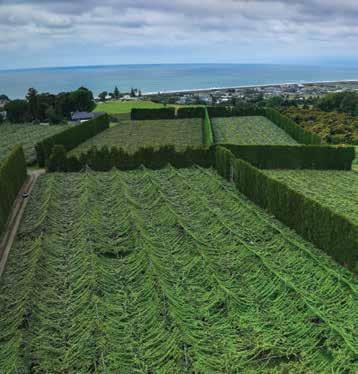
The Whites use drones to obtain a bird’s-eye view of their orchards, which gives an immediate overview of which plantings are doing well, and which might need a bit of extra attention
• Grafting some of their RubyRed onto older Green meant the original root systems had been through not one (2023’s Cyclone Gabrielle) but two (1988’s Cyclone Bola) catastrophic weather events, and suffered for it.
• RubyRed really was new, meaning the Whites (and other triallists) had to learn how to handle it on the fly.
Even after decades in the business they quickly realised that it really does require different treatment.
“It does have a different period of skin sensitivity, and if you don’t thin enough it’s going to throw out smaller fruit… it just needs a bit more love,” Liarna says. “So it’s finicky but, certainly for us, it’s worth it.”
• Provides internal warming more compact flowering
• For use on fruit tree crops
• The “spray on” that adds to all other methods
• Good results have been achieved when applied through irrigation lines







79.3 GRAMS (41.3 COUNT)
85.4 GRAMS (39.6 COUNT)
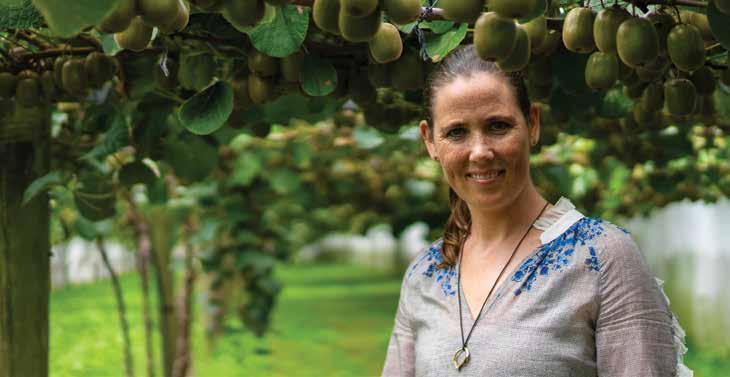
INDUSTRY AVERAGE
91 GRAMS (38 COUNT)
2024 2025
After thinning heavily to improve size, the Whites expect to harvest the larger fruit that people want to eat
One thing John is particularly strong about – and this goes for the Whites’ plantings of Green and Gold kiwifruit as well – is the need to be ruthless when a plant looks like it needs cutting back.
“There’s no point in pussy-footing around and trying to save that lovely new growth,” he says. “If you have too many growth points without a strong enough root system you’re not going to get anywhere, so you have to get that balance right.”
The flip-side of that is that some of the Whites’ RubyRed did suffer due to a hard cut-back but that time it was grafting, rather than pruning, that caused their plants to object.
It does have a different period of skin sensitivity, and if you don’t thin enough it’s going to throw out smaller fruit
“The reality is that when you cut the top off a mature vine you will inevitably get die-back in the root system, and if you add two years of continuous rain to the mix that retraction is only going to get worse,” says John.
“Luckily we’re now at the stage where we’re seeing good recovery in most of the mature plants and can clearly see which of those are never going to recover, so have been able to replace those with 200 new RubyRed (grafted on Bruno rootstock) plants.”
After all that, the Whites are confident RubyRed is responding well to their current management strategy, and it’s only going to get better.
While much of their plantings are not under cover, the passage of time and attention to close-planting has seen the establishment of good leaf canopy, giving vines the protection they need to produce well.
That combined with on-orchard practices like bud thinning (a lot), summer pruning (not too much) and diligent pollination – all done well and on time – is seeing good results.
And the addition of RubyRed’s earlier season (harvest starts in early-March) makes for a smooth work programme.
The maturity of the Ōpōtiki block makes for a good measuring stick and there the Whites saw an increase from 6000 trays in the first year of production to 13,200 trays for 2024, the fifth harvest.
“We expect that to be a little lower this year as we thinned heavier to improve fruit size,” Liarna says.
“But that’s what we want… our aim is always to produce fruit that people want to eat and size is a big contributor to that.
“It’s always about growing the best quality, best-tasting fruit we can and RubyRed is a really exciting part of that journey.”

Two years ago, Cyclone Gabrielle wreaked devastation upon growing areas across Hawke’s Bay, Tairāwhiti Gisborne, Northland, Bay of Plenty, Wairarapa and northern Manawatū. For NZGrower & Orchardist, KRISTINE WALSH finds out how Gisborne vegetable growers are managing the soil.
Two years after Cyclone Gabrielle – and the tsunami of rain that both preceded and followed – things still aren’t right underfoot, say Gisborne growers Calvin Gedye and Dean Davies.
“It’s not really one thing, but we know the soil has not fully recovered so we have to treat it with even more care than we usually would,” Calvin says.
For them, the problem has not so much been silt… Dean says parts of the around 50ha he crops only got a layer of about ten centimetres, and that has worked in well.
However, for both, the erosion of precious topsoil combined with long-term water inundation has affected the composition of the soil.
Important in the early months after a big weather event is staying off the soil wherever possible, balanced with the ever-present need to run a business.
As time has gone on, however, both say putting a lot of thought into cover cropping is key to improving soil health for the long term. That’s always been a thing, says Dean, “it’s just part of how we care for the land”.
“But in the last couple of years I’ve been really focused on planting cover crops with deep tap roots that bore right into the soil and create spaces worms can readily get around.”
For him, that has led to choices like mustard, black oats, clover and radishes. And he won’t put stock in to graze a cover crop – instead working it back into the soil to add organic matter and fix nitrogen. “It’s such an important part of our jobs and our responsibilities,” he says.
“It can be tough to implement on lease properties, particularly with short-term leases where the owner has said they want it to be put back into grass. But we can –and should – do better for the future of the land.”
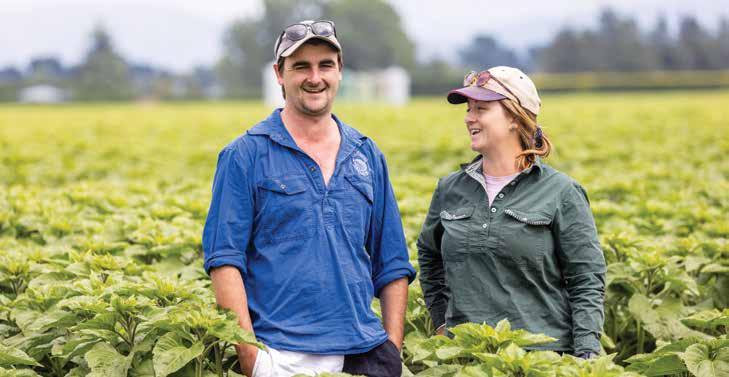
A new generation is stepping up to manage Canterbury potato and arable growers Redmond Ag Farming, with plans to grow and diversify the family business.
Tony Benny
Emily Horck and her younger brother Scott Redmond are the fourth generation to farm the land near Kirwee, taking over from the manager who had been in charge since their father died five years ago.
Their mum, Kathy, looks after finance and administration, while Scott and Emily run day-to-day operations. Emily mainly looks after potatoes and Scott the variety of other crops they grow, the machinery and the livestock that comes and goes on the property.
Previously they had both worked off-farm, Emily at Farmlands first in sales and inventory control and then as a field rep. Scott started a diesel mechanics apprenticeship and worked for a local transport firm.
But as their father Andrew (mostly known as George) became increasingly unwell, their plans changed.
“Dad pulled me out of the apprenticeship because he wanted to show me the farm before he died,” Scott recalls.
But even so, he and Emily were not really planning to come home to manage the farm. “It probably came about quite unexpectedly when our manager moved to a new job last year, so it was a bit of a panic at the start.”
Luckily it was winter at the time, not the busy harvest season, and they realised that in effect they had been training for their new roles all their lives.
“There was a lot of finding our way, but yeah, the base of it was there because we’d grown up around it,” Emily says. “It’s different now because the pressure is on us, but it’s under control really,” she laughs.
Their operation is spread over two farms and a lease block, a total of 280ha. As well as table and seed potatoes,
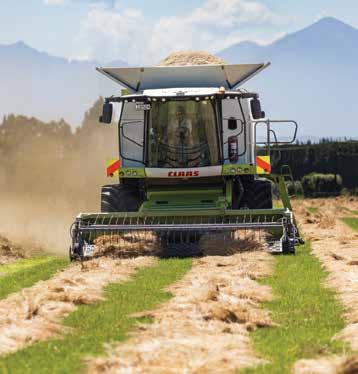

Harvesting ryegrass seed – one of the many crops grown at Redmond Ag Farming
they grow milling wheat and barley, ryegrass seed and sunflowers as well as finishing lambs and a few bulls. Most of their potatoes are grown on leased land, moving to new ground each year.
They grow a range of table varieties for the New Zealand fresh market, sold in supermarkets under various brands.
“We also supply the local pub, the local kindy and Darfield bakery. It’s quite cool that they’re eating our spuds round the whole district,” Emily says.
Growing seed potatoes is another important part of the business, supplying a processing variety preferred by big producers like Talley’s and McCains.
“You’ve got to look after that younger stuff, or the next generations will be hard work.”






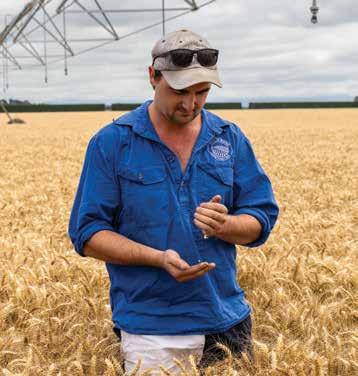
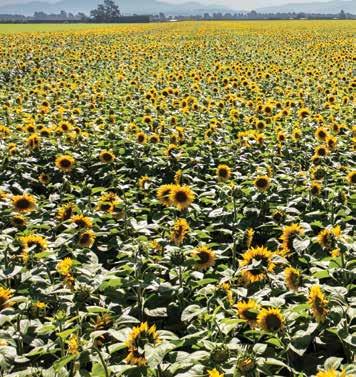
As the potatoes grow, they are monitored closely to make sure they are thriving, and any plant that appears diseased is pulled out when the team go roguing – the practice of walking every row with a fork and a bag, checking the health of every plant.
“This year we walked one paddock four times,” says Scott. “You’ve got to look after that younger stuff, or the next generations will be hard work.”
After harvest, the seed potatoes are stored in the coolstore their father had built in 2015, and the following season they are planted out again to multiply the crop, a process repeated several times. They don’t get paid until they supply the potatoes back to the seed company, the third or fourth generation.
Wheat or barley are a good tool to clean up after other seed crops, other paddocks
“There’s certain size specifications that we have them at, so in the last two or three weeks we’re out weighing and monitoring the size so that they’re not too big or too small, and then we spray them off at the preferred size and then they’ll sit in the ground until they’re ready to harvest,” says Emily.
Like all potato growers, they cope with a variety of pests and diseases, particularly the potato psyllid which relatively recently arrived in New Zealand.
“It changed the whole potato industry in New Zealand because you have to spray every six or seven days. Otherwise it could ruin your seed lines,” Scott says.
Growing a variety of other crops not only spreads their financial risk by not having all their eggs in one basket, but also by facilitating effective crop rotation. “Wheat or barley are a good tool to clean up after other seed crops, other paddocks. It gives you time to clean it, then you can come back around with another rotation.”
They need to be flexible though when markets change, as they have found over the past couple of seasons as demand and prices for ryegrass seed have dropped thanks to a worldwide oversupply.
“They cut back the allocation so all of a sudden you could grow less. There were gaps in the rotation, so this year we’ve got a lot more cereal than we normally would, and we’re growing barley in the spare paddocks and a lot more wheat than previous years.
“They will be good crops, but to get that really good crop there are lots of inputs, and that narrows down your margin – and the margin’s not great anyway.”
Scott and Emily are carrying on the family farming tradition and say they are grateful for the support they have received from industry leaders and other growers as they strive to expand and diversify their business.
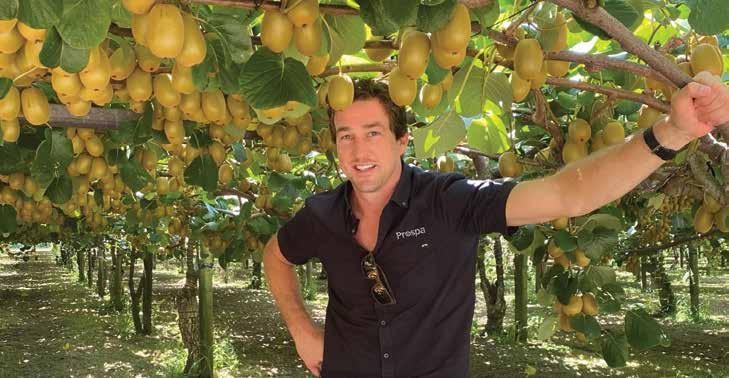
At just 34 years old, Aaron Wright is a key player in the kiwifruit industry. He has worked his way up to general manager of Prospa, EastPack’s orchard management arm, which oversees 1300ha. He sat down with NZGrower & Orchardist’s CARLY GIBBS to share his thoughts on how this year’s Bay of Plenty harvest is shaping up and what helps grow a good crop.
Aaron Wright always prepares for whatever challenges the kiwifruit harvest may bring but never celebrates too early.
The last few seasons have been a “wild ride”, and while this one has been better than previous seasons, it’s still had its ups and downs.
“I’ve gone from extremely hopeful to a little bit concerned, back to quite hopeful again,” he says.
When NZGrower & Orchardist visited Aaron in February on a Prospa-managed orchard on Te Matai Road in Te Puke, signs of a high-yielding harvest were evident.
The Gold orchard was loaded with big fruit, and he predicted they would size even more by the time this issue hit growers’ letterboxes.
Aaron is gearing up for another potentially stellar season for the industry, following last year’s record-breaking harvest of more than 190 million trays of fruit.
Bay of Plenty Gold Prospa crops look similar to the high volume and quality packed last year. Hayward is tracking better than last year, and full-producing red blocks are expected to yield good results, which Aaron hopes will be new records for Prospa.
Aaron has had a colossal career as a third-generation Te Puke grower, climbing the ranks since graduating with a Bachelor of Horticulture Science from Massey University. He started as an orchard supervisor before becoming an assistant manager, then an orchard manager of 50ha, and then an area manager before becoming general manager overseeing 70-plus orchard management staff.
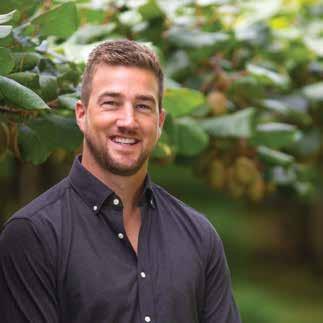
“While much of this is achieved during the growing season, harvest still plays a significant role in the quality outcome”
Aaron Wright, general manager of Prospa

Aaron and his wife Brittany, with their two children, Harper (5), and Brooklyn (3)
He drives a strong, competitive workplace culture, saying, “Taking an orchard from good to great is a true work of art and requires a lot of energy, direction and attention to detail. It’s moving with the punches from season to season, understanding the vines, being a good horticulturist, people manager and planner.”
He owns 1.5ha of green kiwifruit with his wife, Brittany, and two children, Harper (5), and Brooklyn (3), on the same road as his parents, who are growers and former packhouse owners. He is one of three brothers, one a grower and one a harvest operator.
Aaron’s orchard weathered challenging times after neverending rain and a severe hail damage event in 2023, but this year’s crop looks good.
Green orchards everywhere look better thanks to improved pollination this year, and bouncing back from Cyclone Gabrielle in 2023, one of the most challenging seasons some Prospa growers had seen in 20 years.
Since then, there has been a focus on regenerative and soil remediation practices to restore and rehabilitate plant health. Aaron says they aim to consistently grow high-producing crops that pack and store well to ensure Zespri can put high-quality fruit on the market.
“While much of this is achieved during the growing season, harvest still plays a significant role in the quality outcome,” he says.
Last harvest, the industry had an abundance of labour and almost no interruptions from rain, meaning crops
could be picked at their optimal maturity and high quality maintained throughout the supply chain.
“We have strong labour availability and good crops again this year, so it comes down to how kind Mother Nature is willing to be over the next four months.”
Prospa manages 1300ha of kiwifruit (roughly 50/50 Green and Gold) in eight North Island areas.
Taking an orchard from good to great is a true work of art and requires a lot of energy, direction and attention to detail
Reflecting specifically on the Bay of Plenty, he says this season had a promising start after good climatic conditions leading up to bud break but has been a bit of a “rollercoaster” since.
Spring started warm but then got cold relatively quickly, and flowers began to abort. This led to orchard variability in some orchards, with some growing early and others trailing behind.
Hopes for a great season were initially dashed. However, a good pollination season followed by a warm, sunny summer has returned optimism for another good season.
With challenging years behind them, Prospa managed some “outstanding” Orchard Gate Returns (OGR) for growers in 2024 and is on track to repeat them this year. Aaron says, “Grower morale is definitely up.”
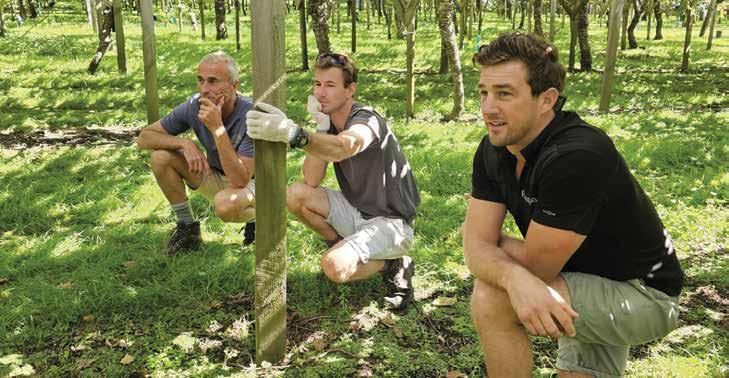
When asked what has allowed them to achieve those results, he says they have evolved into a large business that uses its scale and shared knowledge as a competitive advantage.
They capture data from all orchards, review it regularly to identify ways to improve or adapt, and share that information with their managers.
For example, during Hi-Cane season, managers enter specific data around application rates, times, temperatures and wind speeds for every orchard across their 1300ha. They can then compare the data against production figures, such as winter buds, flower buds and fruit.
“Having data and observations captured across such a large portfolio of orchards and regions, then assessed to find opportunities for continuous improvements is something very few operators in the industry are able to achieve,” he says.
Findings are often shared with their growers through field days. Aaron says growers can feel isolated and keeping connected to find out what is and is not working around you is essential.
Likewise, knowing the difference between a good and a great orchard manager helps. The best OGR outcomes are “a collection of a hundred good decisions planned thoroughly and executed well”.
“Sitting under the vines and just listening is good, too,” he smiles. “It’s cheesy, but it’s looking at them and thinking, ‘How do I ensure they’re able to perform well, not just one year, but the next?’ That’s the art form.”

The New Zealand Fruitgrowers’ Charitable Trust is offering a scholarship for the 2025 academic year.
NEW ZEALAND FRUITGROWERS’ CHARITABLE TRUST
$5,000 LINCOLN UNIVERSITY DIPLOMA SCHOLARSHIP
The New Zealand Fruitgrowers’ Charitable Trust is offering 2 scholarships for the 2021 academic year.
$10,000 POSTGRADUATE SCHOLARSHIP
Application process
The New Zealand Fruitgrowers’ Charitable Trust is offering a $5,000 scholarship in 2024. The scholarship is available to New Zealand residents who are working in, or intend working in, the New Zealand fruit growing industry undertaking study towards a Diploma in Horticulture or a Diploma in Horticultural Management at Lincoln University.
The New Zealand Fruitgrowers’ Charitable Trust is offering a $5,000 scholarship in 2025. The scholarship is available to New Zealand residents who are working in, or intend working in, the New Zealand fruit growing industry undertaking study towards a Diploma in Horticulture or a Diploma in Horticultural Management at Lincoln University. The annual value of the scholarship shall be a maximum of $5,000 towards tuition fees or living expenses.
The New Zealand Fruitgrowers’ Charitable Trust is offering a $10,000 scholarship. The scholarship is available to people undertaking postgraduate study specifically related to the fruit growing industry.
A completed application and references must be submitted to HortNZ by 5pm, 20 March 2021. The forms are available on the HortNZ website: www.hortnz.co.nz/scholarships
The annual value of the scholarship shall be a maximum of $5,000 towards tuition fees or living expenses. $2,500 will be paid out in Semester 1 and on condition that all Semester 1 courses are successfully completed a second $2,500 will be paid out in Semester 2.
Please email your completed forms to schols@hortnz.co.nz
For more information, you can phone Jacqui Stalknecht on (04) 494 9978
$5,000 LINCOLN UNIVERSITY DIPLOMA SCHOLARSHIP
Application process
Application process
Applications for this scholarship close on 30 April 2024.
The New Zealand Fruitgrowers’ Charitable Trust is offering a $5,000 scholarship in 2021. The scholarship is available to people undertaking their first year of study towards a Diploma in Horticulture or a Diploma in Horticultural Management at Lincoln University.
Applications for this scholarship close on 30 April 2025. Further information and application forms are available from the Lincoln University website: https://www.lincoln. ac.nz/study/scholarships/search-scholarships/new-zealandfruitgrowers-charitable-trust-horticulture-scholarship
Further information and application forms are available from the Lincoln University website: www.lincoln.ac.nz/study/ scholarships/search-scholarships/new-zealand-fruitgrowerscharitable-trust-horticulture-scholarship at
The annual value of the scholarship shall be a maximum of $5,000 towards tuition fees or living expenses. $2,500 will be paid out in Semester 1 and on condition that all Semester 1 courses are successfully completed a second $2,500 will be paid out in Semester 2.
Application process Applications for this scholarship close on 1 March 2021. Further information and application forms are available from the Lincoln University website: www.lincoln.ac.nz/ scholarships
Please note that the Selection Teams for this scholarship will be looking for:
Please note that the Selection Teams for this scholarship will be looking for:
• Commitment to the fruit growing industry.
• Commitment to the fruit growing industry.
• Potential contribution to the fruit growing industry.
• Potential contribution to the fruit growing industry.
• Past achievements.
• Past achievements.
Please note that the Selection Teams for both scholarships will be looking for:
• Commitment to the fruit growing industry.
• Past achievements.
• Individual approach, qualities and skills.
• Potential contribution to the fruit growing industry.
• Individual approach, qualities and skills.
• Individual approach, qualities and skills.
• Referees’ comments.
• Referees’ comments.
• comments.
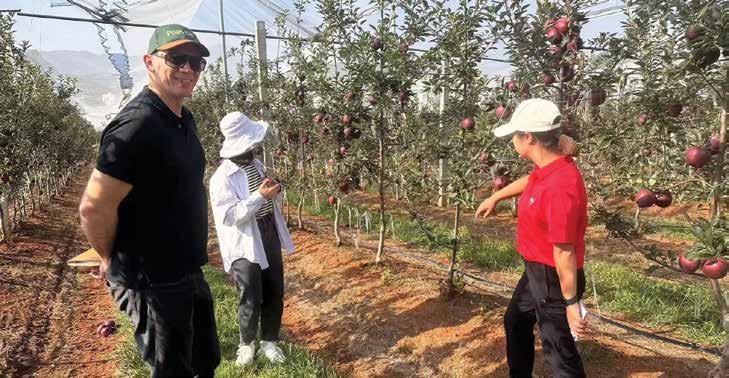
As New Zealand’s apple harvest gets underway, the global marketplace is throwing up some challenges for marketers hoping to deliver strong returns for growers.
Prevar chief executive Tony Martin says that New Zealand’s premium IP varieties and strong position in Asian markets should give us reason for optimism, however avoiding complacency means there are decisions to be made.
NZGrower & Orchardist staff
New Zealand’s apple harvest in 2025 looks excellent and a return to form after a couple of challenging seasons. The annual crop estimate by NZ Apples & Pears predicts a ten percent increase in exports, from 19.1 million Tray Carton Equivalents (TCE) in 2024 to a potential 21 million TCE in 2025. Those figures, combined with South Africa’s exports up 5.5 percent and Chile’s exports up one percent, are driving the World Apple and Pear Association’s forecast
of a total 5.3 percent increase in exports across the Southern Hemisphere.
“There is a lot of fruit out in the global marketplace at the moment,” says Prevar chief executive Tony Martin. “The Northern Hemisphere has also had big supply increases over the last couple of years, particularly out of Washington State. So, supply is looking a little bit out of balance. That’s going to put some pressure on retaining market pricing for sure.”
The haltering economy and downgrade in discretionary spend in China – New Zealand’s largest export market – is putting further pressure on pricing. Production in China is outpacing consumer demand; however, New Zealand’s fundamental proposition remains strong.
“We’re very fortunate that we have Asian markets on our doorstep where in many of those countries they don’t grow the same types of fruit as us and certainly not in the same way as us.”
New Zealand growers deliver more than 60 percent of China’s imported apples, according to a recent report from the United States Department of Agriculture. However, US apple growers, who are facing unprecedented overproduction and declining domestic consumption, are pushing into new markets.
We’re very fortunate that we have Asian markets on our doorstep where in many of those countries they don’t grow the same types of fruit as us
“The US is definitely getting a stronger foothold into China, Taiwan and Vietnam. The Washington Apple Commission has done a fantastic job of leading that out in different parts of the world and promoting apples from Washington State as a collective.”
It’s an approach that Tony believes New Zealand can learn from.
“New Zealand Trade and Enterprise, for example, was really stepping in to provide platforms for New Zealand growers and exporters to work together with the ‘Made with Care’ campaign. There have definitely been some good efforts starting up in that place, but we need to do more of it.
“Your competitors are not the growers down the road here in Hawke’s Bay or in Nelson. Your competitors are apple


Prevar is a private joint venture company owned by New Zealand Apples & Pears Incorporated, Plant & Food Research (New Zealand) and Apples and Pears Australia Limited. Since 2004, Prevar has developed and commercially licensed 18 varieties, including Rockit™, Dazzle™, Joli™, and many others.
suppliers from other markets, other fruit categories and other products that are competing for the share of that discretionary spend around the snacking occasion.”
Berries in particular, and processed snack foods have done well in carving out that market. The apple industry hasn’t always been great at telling the story about why apples should be the snack of choice, Tony says.
Waimea has been at the forefront of bringing new rootstocks and varieties to NZ, to assist growers in having some of the most highly efficient and productive orchards in the world.
We are pleased to be continue this with the production of trees on Gisela® cherry rootstocks and Geneva® apple rootstocks.





Please contact the Sales team to discuss availability:
Grant Bryan, 0274 201 003, grant.b@waimea.group
Kate Marshall, 0274 201 033, kate.m@waimea.group


www.waimeanurseries.co.nz
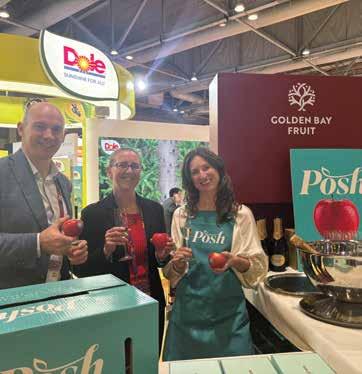
Prevar-developed variety PoshTM, licensed to Next Generation Apples (a partnership between Golden Bay Fruit and Taylor Corp), at the Asia Fruit Logistica trade show in Hong Kong last year
“It’s not helped by the fact when you walk into a supermarket, the apple category is very noisy. I think over probably the last two decades, it’s gone from being quite a simplistic category to being absolutely flooded with varieties, brands, and has really lost its way. I heard a statistic last year that there are 180 apple varieties available commercially in different parts of the world.
“Retailers have been put in a good position because they can make choices between multiple growers, because there are too many apple varieties being thrown at them. It puts pressure on price, and the grower ends up being in a worse position. Consumers are overwhelmed. They don’t know what each apple stands for.”
Instead of waiting for industry consolidation to rationalise the number of commercial varieties available, a sprinkling of new grower brands – including from growers here in New Zealand – is attempting to cut through the variety noise with their individual producer stories.
“We know there’s a growing global movement of consumers who want to feel closer to the producer. So I can see why there’s a push for some to go down that pathway. But if we look at where success has really shown up across the fast-moving consumer goods category and certainly
~50% OF NEW ZEALAND’S APPLE CROP IS MADE UP OF IP (INTELLECTUAL PROPERTY) VARIETIES.
into fresh produce, it’s around developing a consumer brand, not a grower brand.
“So I think there are choices that growers have to make around which pathway they want to take. To grow a consumer brand costs a lot of money. It’s a deep investment over a long period of time. So those two different pathways offer two different choices for growers to take and for different reasons.
“At the same time, I think the opportunity is to really keep pushing the edge of what variety innovation in the apple industry looks like.”
Innovation has been a key factor in the New Zealand apple industry punching above its weight – close to 50 percent of New Zealand’s crop is made up of IP (Intellectual Property) varieties.
“We have been breeding premium quality apples for a long period of time. And it’s not just about getting a piece of fruit to market. There is a lot of intellectual property that sits in and around that process, which creates a differentiating factor. For example, production systems, how fruit is managed through the production stages and post-harvest treatment and storage of fruit all the way through to the supermarket shelf.
“The other piece that I add on top of that is brand development. You can have a great product, a great variety, but if it doesn’t have a good brand story and connection with the consumer, then it’s going to be hard to get the sale through.
“You’ve got to give a distinctive point of difference that provides the grower with an economic benefit and the consumer with a viable alternative to other fruit or snack choices.
“Rockit™ was one of the first in the apple category to truly challenge the thinking around the eating occasion. And then at the other end of the spectrum, when we think about the Asian consumer in some markets where eating an apple is a sharing occasion, you want a big apple so you can slice it up and share it with other people.
“So you’ve got these two quite distinctive ends of the eating occasion spectrum, but then there’s a whole lot of other varieties competing in the middle space, which is just to be in the fruit bowl. I think there are opportunities for more innovation and being much more selective and defined around what those eating occasions are.”
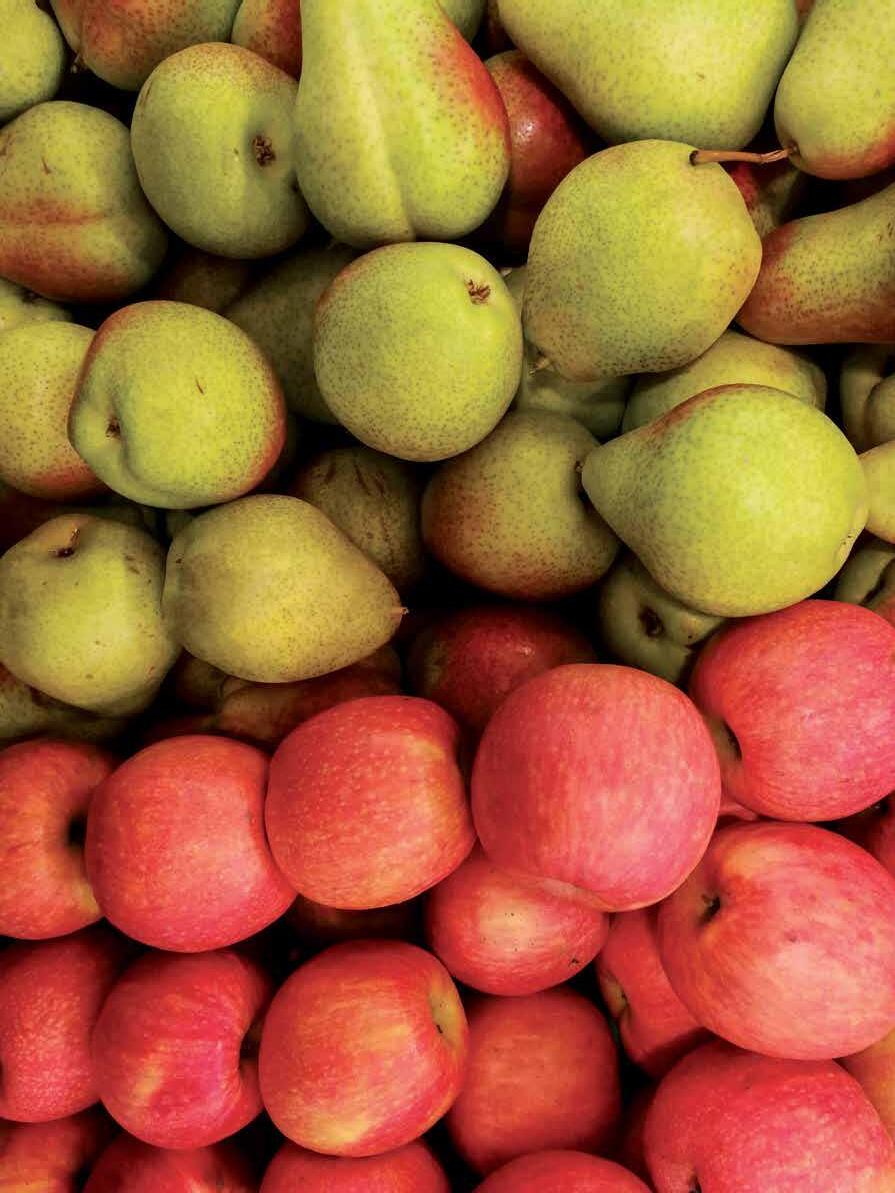
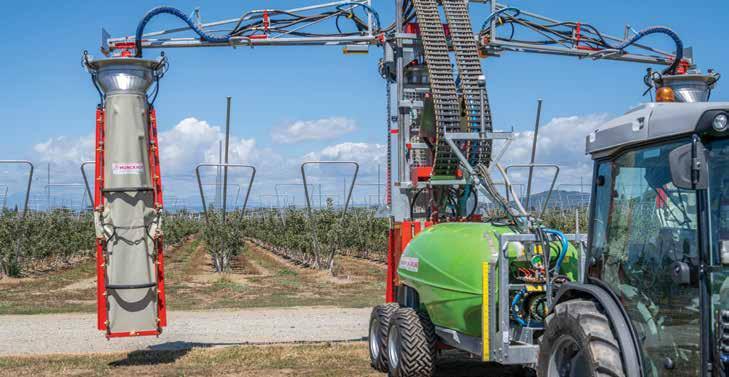
Canterbury’s apple industry is taking another leap forward with a 250ha dairy-to-apples conversion. Half Rockit™ and half Joli™, the orchard is the first Canterbury pipfruit operation for the New Zealand Superannuation Fund as well as the first planting of T&G Global’s Joli apples in Canterbury.
The New Zealand Superannuation Fund rural investment manager FarmRight set out to find a property which had the best natural resources, such as soil type, water availability, growing degree days and location, says Ed Tapp, FarmRight’s general manager of the NZ Super Fund Portfolio.
“Canterbury-specific considerations were covered in site selection, most notably being coastal to reduce frost incidence, and more temperate during the growing season. The property that met these criteria happened to be a dairy farm. Being a dairy farm allows for a profitable operation both during and after the conversion.”
NZGrower & Orchardist staff

The property, purchased in June last year, will be planted with 250ha of premium varieties (half Rockit and half Joli) with 140ha remaining as dairy land.
The orchard’s Joli plantings are part of an established partnership between the New Zealand Superannuation Fund (owner), FarmRight (manager) and T&G Global (variety rights and marketing), which has successfully developed Envy™ orchards in Tasman (Appleby and Riwaka) and Hawke’s Bay (Rosewood) since 2021.
T&G chief operating officer apples, Shane Kingston, says commercialising new plant varieties
The orchard
• A Mid Canterbury orchard in the Pendarves area converting from dairy to apples, with 250ha of canopy area and 140ha remaining as dairy land
• Using modified 2D V trellis system chosen for increased canopy area per hectare and using multi-row spray units for increased efficiency
• Planting schedule: 125ha of Rockit™ and 25ha of Joli™ planted in 2025, followed by 100ha of Joli™ in 2026
• Joli™ V system specifications: 3.6m row spacing with 14 fruiting wires per row (7 per side)
The owner and manager
• New Zealand Superannuation Fund owns the land and development, with FarmRight as managers
• A dedicated FarmRight orchard team, including recently appointed manager and operations staff, began in January
that can be grown in different geographies and climates is important to adapt and build resilience.
“Canterbury provides an excellent opportunity for diversification due to its flat land availability, fertile soils, reliable water sources, drainage, adequate winter chill, favourable rainfall, and sufficient growing degree days. Additionally, by having some of our premium apple brands supplied out of the South Island, it enhances our risk mitigation, allowing flexibility to deliver quality fruit to our global markets.”
can be
Shane says Joli branded apples have strong adaptability that allows them to perform well across multiple regions, ensuring a diversified and resilient supply base across New Zealand.
Joli apple volumes are contracted to go through T&G’s Nayland Road facility in Nelson, which Shane says will be able to manage current planned South Island volumes.
“This facility is supported by our proven road freight logistics, which ensures fruit quality is maintained. As volumes scale in the future, we will explore whether additional post-harvest facilities might be required in the South Island.”
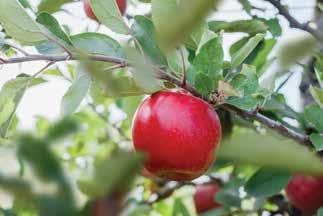
Launched in 2023, Joli™ is T&G’s newest premium apple, sitting alongside its Envy™ and Jazz™ brands. T&G currently has 55ha of Joli branded apples planted in Hawke’s Bay, and by the end of 2026 it plans on having 250ha planted, including the 125ha in Canterbury. The first commercial Joli harvest will be in 2027. Over the next four to five years, as additional trees become available, T&G has plans to extend the opportunity to grow Joli to growers in Europe and the United States.
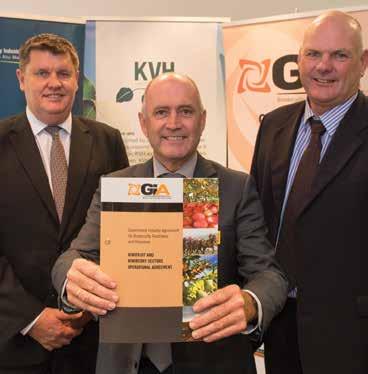
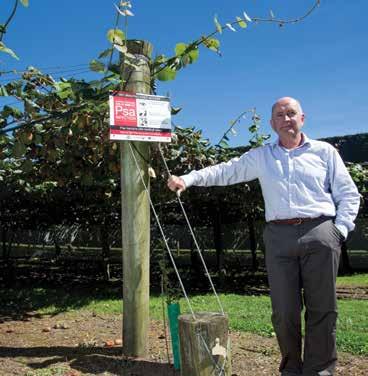
After ten years on the Horticulture New Zealand board – and six years as chair –Barry O’Neil is stepping down at the end of March. For NZGrower & Orchardist he shares his experience leading from both sides of our industry’s sometimes challenging yet crucial partnership with government.
The recent Oriental fruit fly incursions in Auckland have brought the work of the Fruit Fly Council, one of the Government Industry Agreement (GIA) partnerships, into sharp focus.
For Barry O’Neil, outgoing Horticulture New Zealand chair, the response since January shows that the partnerships between industry and the Ministry for Primary Industries are doing their job – albeit, as always with anything, with room for improvement.
“It’s not perfect. I’m sure we can make it better. At times it’s too clunky and too administrative, but it’s great that we’re around a table together and deciding together
John Gauldie
what needs to happen. So I think the model is the right model. But as I said, I think it can and will be improved over time.”
That New Zealand biosecurity can benefit from industry-government collaboration at all – a key defence against one of the greatest threats to our horticulture industry –is testament to Barry’s belief in strong ties between government and industry.
Barry grew up in a primary sector farming family in Manawatū, later moving to the Bay of Plenty. After Te Puke High School, he graduated from Massey University in 1978 with a Bachelor of Veterinary Science.
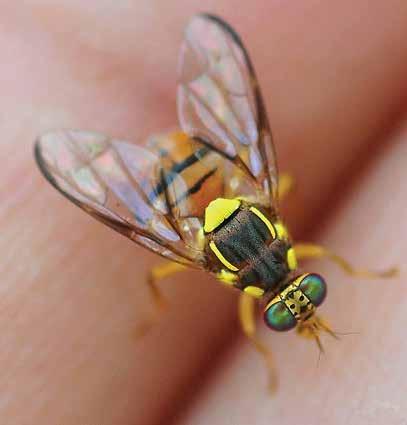
The response to recent Oriental fruit fly incursions demonstrates the work of the Fruit Fly Council, one of the Government Industry Agreement partnerships
He worked in private veterinary medicine, where he developed an interest in regulatory efforts to keep diseases like foot and mouth out of New Zealand. That interest took him to the Ministry of Agriculture and Fisheries (MAF), becoming the Veterinary Officer for Bay of Plenty.
“When I joined government the bureaucracy at times nearly did my head in. I hated it. Actually I planned to be there no more than two years and then get out because of that bureaucracy. I wasn’t used to it.
“Then I thought, well Barry, if you don’t like it, why don’t you stay and make a difference and show some leadership?”
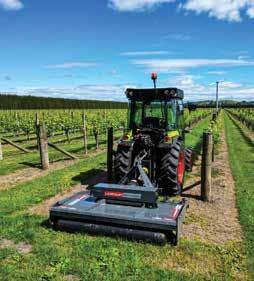
He went to Brussels for four years as New Zealand’s Veterinary Counsellor to the European Union. Returning to New Zealand in 1994, he was appointed Chief Veterinary Officer within MAF, then five years later he became the group director of the Biosecurity Authority within the Ministry of Agriculture and Forestry.
“I recognised that the animal biosecurity readiness and response was much better than the biosecurity around plants, forests and marine.”
It’s great that we’re around a table together and deciding together what needs to happen
As group director Barry was part of the Biosecurity Council which published the influential 2003 Biosecurity Strategy for New Zealand. The strategy proposed a single agency to manage biosecurity across the primary sector and envisaged joint funding and decision-making with industry – a first step toward the GIA.
Later that year, Barry was appointed Assistant DirectorGeneral in charge of the new Biosecurity New Zealand, the first time a Crown agency had responsibility for an integrated approach to biosecurity.
He then led a project to bring MAF Quarantine Service and Biosecurity New Zealand together and became Deputy Director-General.
Barry left government in 2012 as MAF was absorbed into the new Ministry for Primary Industries, including Biosecurity New Zealand, which remains a business unit within MPI today.
He became chief executive of Kiwifruit Vine Health (KVH), which had been recently established to deal with the industry response to the Psa incursion.
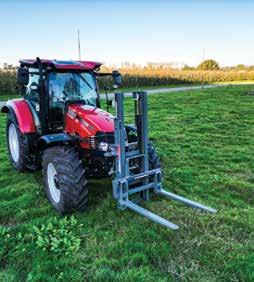

In 2009 Minister David Carter, who held the portfolios for Agriculture, Biosecurity and Forestry, joined Barry and his wife Hilda at an event acknowledging Barry for receiving the OIE (World Organisation for Animal Health) gold medal for his outstanding service
Progress toward stronger industry and government collaboration was coming to fruition.
In 2014, under his leadership, KVH signed up to the GIA for Biosecurity Readiness and Response, which Primary Industries Minister Nathan Guy called a historic moment for biosecurity in New Zealand. Much of the current fruit fly response stems from the operational agreement developed afterward.
“We were the first industry body to sign up to GIA because we strongly believed we needed to work in partnership rather than throw rocks at government.”
With his biosecurity background and experience as a grower, Barry became a sought-after director within industry good governance
Today, two decades after the GIA was originally proposed, government and industry have finalised 28 operational agreements to work collaboratively and co-invest to prepare and respond to biosecurity risks.
While leading KVH, Barry was also running his own kiwifruit orchard.
He had begun growing kiwifruit and avocados in the Bay of Plenty back in 1984 at Whakamārama before his government roles took him to Wellington and overseas. Returning to live in the Bay of Plenty with his wife Hilda,
he took up growing again with a new orchard on 6ha at Ongare Point.
With his biosecurity background and experience as a grower, Barry became a sought-after director within industry good governance. He joined the board at Scion and in 2014 he joined the HortNZ board as an appointed director due to his biosecurity experience.
In 2019 he was asked to take over as chair of HortNZ. However, he decided to first offer himself as a grower director for election instead of a board appointment.
“My belief is, in an industry good organisation, it’s better to be elected by the growers to have a clear mandate from the members.”
In 2018, he stepped down as chief executive of KVH. However, he remained busy as ever with governance appointments on – amongst others – the board of the National Science Challenge Our Biological Heritage –which brought together biosecurity and biodiversity research – and he has also served on the Bio-Protection Research Centre board.
These roles brought him into contact with another key facet of industry and government collaboration – coinvestment in innovation and productivity. In 2018 the government launched Sustainable Food and Fibre Futures (SFFF) to pursue targeted co-investment with industry.
“SFFF is now the government’s main tool they have available to support primary sector growth, where government will pay 40 percent and industry pay 60 percent, replacing the previous Primary Growth Partnership 50/50 approach.”
The Crown has committed $270 million in 260 projects that, combined with private sector investment, are expected to total over $600 million by 2031.
SFFF is expected to produce $1.1 billion in net benefits across the primary sector over ten years, rising to $4.3 billion after 30 years.
Within horticulture, the fund has been instrumental in establishing large co-investment programmes like A Lighter Touch, the Humble to Hero project with Onions NZ and the Sustainable Vegetable Systems project – as well as many other smaller projects – often leveraging industry funds from levies.
Speaking with another of his hats on – Barry is chair of TomatoesNZ – he says, “Most of the product group levy goes into research for their growers, as it should to help them to focus on new tools and techniques for growing food.”
Unlike many other countries with substantial government agricultural subsidies, New Zealand has a user pays market-based model – an approach to innovation that Barry supports.
Industry good organisations, as long as they’re performing and doing their job, are very helpful for a government to work with
However, he highlights that government could do a lot more to support growers, who are providing healthy and affordable food for New Zealanders and supporting our economy through trade. Particularly for smaller growers, the cost of technology transition is prohibitive. Policy levers and mechanisms could improve access to capital.
“I’m not expecting a government handout of cash, but a Kānoa fund type mechanism where you could access an interest free loan for a period of time could be another mechanism. For example, if I’m a tomato grower and I pay Emissions Trading Scheme costs, why doesn’t the government capitalise those costs to then enable me to access that capital to change from a coal burner to wood biomass burner?
“Or it could be things like shorter depreciation of your capital investment – a 25-year economic cycle of your capital asset, that’s a long time in today’s world.
“So I think the opportunity with this government is to explore those different potential avenues.”
That will be the challenge for the next cohort of horticulture industry leaders. Barry, who has spent his career navigating the turbulent headwaters where primary industries and government meet, is shifting his focus back to making a difference in government. In September he was appointed to the Environmental Protection Authority (EPA) board, where he is currently deputy chair.
The machinery of government is obviously a different beast than being a grower, but Barry believes being part of both has helped him advocate for better outcomes for horticulture in New Zealand.
“Industry good organisations, as long as they’re performing and doing their job, are very helpful for a government to work with and to engage with and develop a more strategic relationship.
“In my experience it’s such a relief for government to be working with a credible organisation like HortNZ that is looking at the whole, and to the future and coming up with sound, sensible, logical proposals.
“If it’s working right, you can have a degree of trust with an organisation like that. So as a government, you can be more open and forthcoming about some of your thinking than you can with some of the other more noisy parts of the system.”
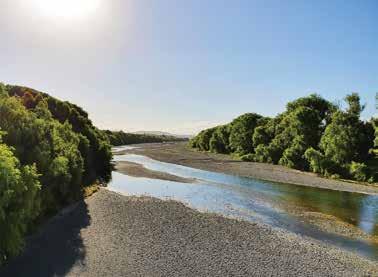


In his most recent seasonal outlook, Chris Brandolino, NIWA (National Institute of Water & Atmospheric Research) principal scientist – forecasting, notes that while a La Niña Advisory is in place, the event is weak and expected to be short-lived.
Ocean conditions in the central equatorial Pacific depart from the typical pattern associated with most La Niña events. This has resulted in a so-called La Niña Modoki (Modoki being a Japanese word for ‘similar but different’).
Generally, La Niña manifests in New Zealand with prevailing east to northeast winds, but in this event we have seen more east to southeast winds – resulting in atypical airflow patterns. After the fifth warmest December since 1909 followed by an unusually cool January, most growing regions settled into warmer and drier conditions during February. While not standout summer conditions, the more settled weather has been welcomed, particularly for the growers getting their harvests underway.
In some regions, that dryness is developing into meteorological drought conditions, particularly in the Ruapehu district and Taranaki.
Northland and Bay of Plenty saw a bit more rainfall than normal and higher temperatures. Growing areas in
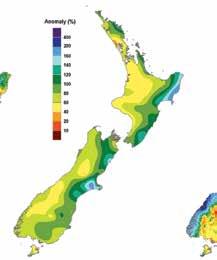
Pukekohe, Waikato, Manawatū and Central Hawke’s Bay have also had less rain and higher temperatures, leading to very dry conditions – an effect also seen strongly in Central Otago.
Speaking in the last week of February, Chris expects that dryness to only get worse as a deficit of rain builds over the next weeks. Nevertheless, the risk of occasional heavy rain events remains distinctly possible, particularly for the northern and eastern North Island, raising the threat of run-off.
Growers in areas of developing dry conditions can check the New Zealand Drought Monitor and Drought forecasting dashboard on the NIWA website to keep track of developments: niwa.co.nz
Precipitation was near normal for most growing regions in New Zealand according to preliminary summer data from NIWA, however weather patterns from the southeast, atypical for La Niña, brought above normal rainfall along the east coast of both islands.


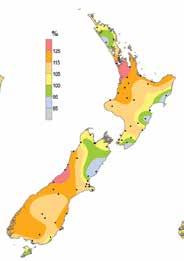

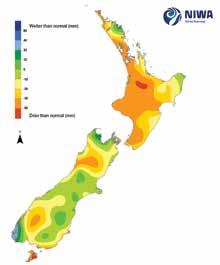
BRIGHT SUNSHINE ANOMALY FROM EARLY DECEMBER TO LATE FEBRUARY
Growers in Gisborne and North Canterbury received the low end of normal sunshine, however plenty of fine days were expected later in February.
MEAN TEMPERATURE ANOMALY FROM EARLY DECEMBER TO LATE FEBRUARY
Despite a cool January, February’s late summer warmth caused a near-normal three-month mean temperature for most of the country.
Due to antecedent wet conditions in Gisborne, Tasman and around Kerikeri, the underlying soil moisture should prevent these areas experiencing very dry or drought conditions as a precipitation deficit persists throughout March.
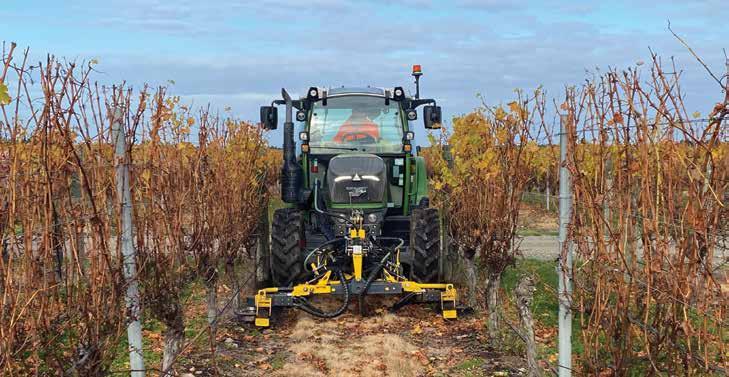
The SFFF project ‘Precision weeding with a smart waterjet weeder, not chemicals or cultivation’ looked at vineyard weed control. The results of the trial are equally relevant to other fruit growers.
Allister Holmes : Lincoln Agritech agronomist
New Zealand grape and other fruit growers currently control weeds in vine or tree rows using glyphosate and other herbicides.
In 2023 Lincoln Agritech was approached by a group of South Island grape growers to help them investigate a nonherbicide way of controlling weeds in vine rows. The growers had seen a machine manufactured in Europe using highpressure water to control such weeds. So they purchased the machine from Western Australia, as shown in Figures 1 and 2 , and developed a Sustainable Food and Fibre Futures project ‘Precision weeding with a smart waterjet weeder, not chemicals or cultivation’ to evaluate the new-to-New Zealand high-pressure waterjet weeder in vineyards.
The aim of the project was to introduce the high-pressure waterjet weeder to New Zealand vineyards to test the
control of weeds in vine rows. If successful, the technology would provide an additional tool for weed control and the group of vineyards could use 50,000 fewer litres of herbicide each year on their own 5000ha of vineyards.
Methodological rationale and design
The trial design was for replicated trials on Canterbury and Marlborough vineyards to evaluate the waterjet weeder versus the current herbicide weed control programme, which was based on well-established methodologies. It would assess above-ground weed biomass before and after each treatment, and the presence of critical weed species. Later in the project we planned to add vegetation-sensing and valve technology to the waterjet weeder, to allow each head to turn on and off as it sensed green material in the herbicide strip, so reducing the water use.
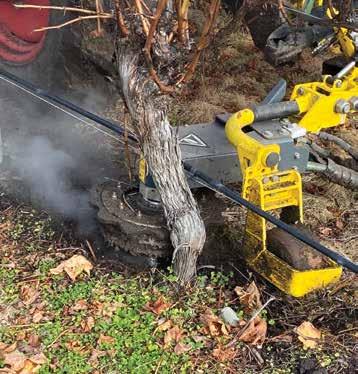
Initial set-up and trialling identified several issues:
1. To adjust the width of the unit, the operating heads slide on a steel frame, which was easily damaged.
2. To achieve a satisfactory level of weed control, the tractor could not travel faster than 2km/h, resulting in a very low work rate, around 0.5ha per hour. This slow speed also resulted in a very high water use, of up to 1500l/ha.
3. The relatively small diameter of the head resulted in an untreated strip in the under-vine area after the up-and-back treatment of vine rows.
4. Because it disturbs the soil and damages weeds, rather than cutting the weeds off at ground level, the water jet has a mode of action similar to soil cultivation weeders.
5. Established weeds such as mallows and nightshade were often not killed, because of their woody stems and upright nature.
The difficulties we encountered under our trial conditions meant that we did not establish and assess the replicated trials. The trial partners did not feel adequate levels of control were achieved to compare with existing weed management practices.
Because of these issues, we decided not to add the vegetation sensing and valve technology to the waterjet weeder. The project team investigated changing the water
jet orifice, but because the unit operates at water pressures up to 1000 bar (14,500 psi), specialist and expensive hoses and fittings are required for any repairs, and specialist knowledge is required to modify the high-pressure waterflow.
This project found that in its current form, the highpressure waterjet weeder that was trialled is not suitable for controlling weeds in the vine row in New Zealand vineyards. Despite these findings, the fact remains that consumers are increasingly shunning the use of herbicides such as glyphosate. Driven by this, and by the rapid increase in herbicide-resistant weeds worldwide, the need for nonherbicide weed control options is increasing.
We know from the New Zealand grapevine industry and orchardists of other high-value fruit crops that they urgently want to advance their weed management options with nonchemical solutions. One of the vineyards in this project says that it is planning for the loss of glyphosate within five to ten years and has to investigate different technologies for weed control.
High-pressure waterjets could be part of the resulting mix of technical solutions for controlling weeds; however, this waterjet technology requires substantial advancement and fresh thinking.
Thank you to all the vineyard staff who undertook the hard work of installing, troubleshooting and operating the machine. Thank you also to the grape growers who supported this work. These include Waiata Vineyard, Cloudy Bay, Pernod Ricard, Indevin, Villa Maria and Yealands Wines.
Note that no financial or technical support was received from the European manufacturer or its New Zealand importer for this work.
Call our experts 0800 130 905 www.irrigationexpress.co.nz
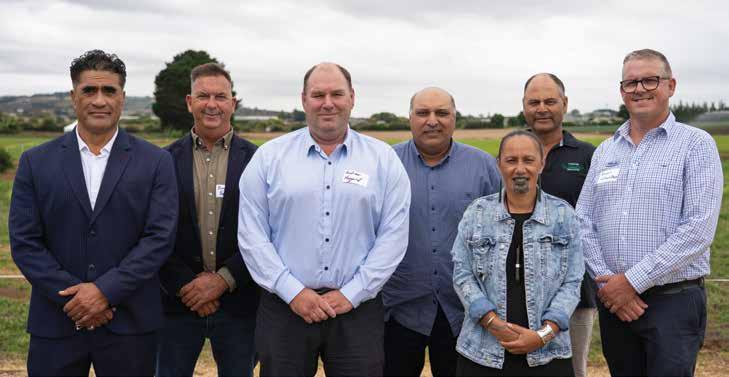
Last month Pukekohe hosted the inaugural Vegetables Big Day Out event. HELENA O’NEILL went along to learn more about the innovations underway in the vegetable industry.
Two days of in-field demonstrations, along with classroom presentations and discussions, drew a crowd of more than 200 people from across the wider vegetable industry.
The event was hosted by the new Te Ahikawariki Vegetable Industry Centre of Excellence (VICE), with participation from A Lighter Touch, Plant & Food Research (PFR), and the various vegetable product groups.
Bobby Lowe, whose family business SKL Produce grows spring onions and Shanghai bok (pak) choy at Runciman near Pukekohe, says it was a well-organised event with great indoor and outdoor sessions.
“Seeing new tech and growing methods firsthand was a highlight. There were plenty of valuable takeaways – well done to the teams at VICE, Vegetables NZ, A Lighter Touch, and Plant & Food Research.” He particularly enjoyed the agri-tech speed dating and networking event.
“It was such a great way to connect with industry innovators. Agovor and CropX stood out to me with their smart solutions, which are making a real impact on farming efficiency. I’m excited to see how these technologies evolve.”
VICE aims to continue to work towards better research and extension outcomes across the vegetable sector. The Pukekohe research farm site will be made available for future in-field research, with the building of future partnerships and collaborations ongoing.
More than $2 million was awarded by the government to the project which is run from the Cronin Road site on the outskirts of Pukekohe. The site has been donated by Balle Bros and is shared with Plant & Food Research.
VICE project lead Kazi Talaska says that in the four months since funding was received, the Vegetable Industry Centre of Excellence project has approved 11 different extension
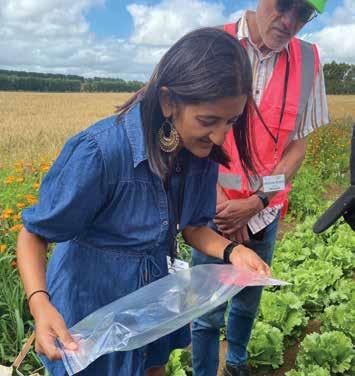
Plant & Food Research entomologist Asha Chhagan checks for beneficial insects after doing a sweep net in the flower strip next to a trial crop of lettuces. Photo by Helena O’Neill
and research projects for funding, some of which were on display during the Vegetables Big Day Out.
“We have heard from our sector that the research pipeline and good applied extension are important, and the attendance from the industry has supported this.”
She says that a conversation that started by addressing how to support demonstration to growers has turned into a conversation about the future of applied research, grower extension and people capability, into the best way to use advancements to address environmental outcomes.
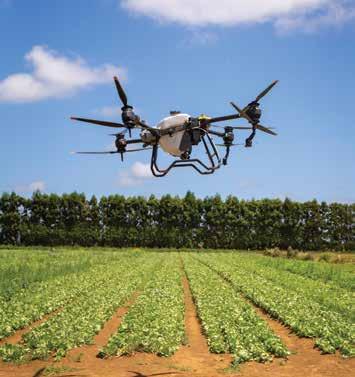
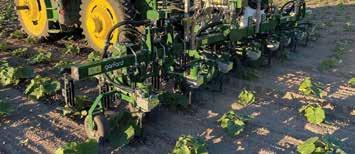
ROBOCROP INROW WEEDER
There were plenty of valuable takeaways – well done to the teams at VICE, Vegetables NZ, A Lighter Touch, and Plant & Food Research
“This project is an enabler and accelerator of research and adoption of best practices that allow for better environmental and grower outcomes.”
Kazi says that VICE has since established a governance group and working groups, secured land for future research, bought a tractor and sprayer for the farm, has had seven post-graduate scholarships under consideration, and supported two summer studentships (one in Pukekohe and the other in Hawke’s Bay).
Like new condition – only covered 130 ha from new 8 row units at 75cm row spacing
3 Cameras
Hydraulic driven rotors cultivate around each individual plant for ultimate weed control
Oil Cooler, Lights, Hazards Panels, Toolbox
For sale due to change in production system Contact Sam Lindstrom:
Hydraulic side shift hitch to keep machine in centre of row
Row units and cameras can be moved to suit different crops and row spacings etc Can be used as a simple row crop cultivator with the ‘Inrow’ rotors turned off Includes all parts, wiring, monitors, cables, manuals to get up and running. Also includes multiple spare parts with various tines, mounts, and blades to suit different crop configurations. Huge savings on chemical and labour costs! www.garford.com
+
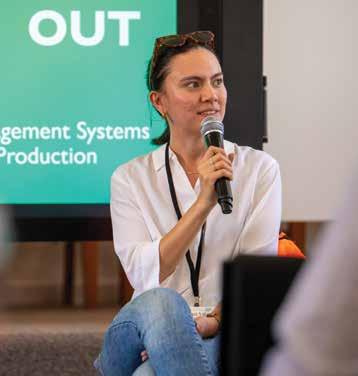
Roimata Minhinnick, co-chair of Te Tautara o Pukekohe Trust and a partner to the Te Ahikawariki Vegetable Industry Centre of Excellence (VICE) project, welcomed Biosecurity and Associate Agriculture Minister Andrew Hoggard to open the two-day event.
“We do recall the messages you left behind at your previous visit. One of them was that our projects should be nationally applicable … All of the projects we have invested in here are nationally applicable.”
Roimata is one of three iwi reps who share a rolling position on the governance board.
“One of the waka that we journeyed on to get here was one of innovation. Collectively we took an innovative approach and part of that was whanaungatanga, being collaborative and working together. We’ve also got an innovative design, we’re still hopeful for innovative investment too.”
Andrew Hoggard spoke about the vegetable industry’s economic importance – $721 million in exports and a domestic value of over $1.5 billion. The government has set an ambitious goal to double the value of vegetable exports within the next ten years.
Howe Young, who oversees the Balle Bros demonstration farm, says the government should look at growers as doing more than just providing vegetables.
“We are the health and wealth of New Zealand. The government should be encouraging people to eat more vegetables. You can control diabetes by your diet and have fewer hospitals.”
Howe says vegetable growers have kept the food index price low, but growers cannot sustain that long-term.
“The last 12 months have been horrendous for growers. I can’t remember a time in the past 10 to 20 years that we have been seeing these prices. We need to lift the prices for the vegetable industry otherwise we won’t survive.”
The Minister says the industry needs regulatory changes to support crop rotation and biosecurity, ensuring a more resilient and competitive sector. “There is work that needs to be done around the cost-benefit analysis in investment in encouraging people to improve their diets. What is that payback in terms of the health system.”
Te Tautara o Pukekohe Trust (which was represented by Roimata at the event) was recently formed by a collective including Ngāti Te Ata, Ngāti Tamaoho, Ngāti Tipa, Horticulture New Zealand, Pukekohe Vegetable Growers Association, Auckland Council, Waikato Regional Council, and the local board. The trust’s key project is the Pukekohe Integrated Catchment Plan, which promotes innovative, culturally and environmentally aligned vegetable production in New Zealand.
We are the health and wealth of New Zealand. The government should be encouraging people to eat more vegetables
Edith Tuhimata, manager of the environmental unit at Ngāti Tamaoho, began the second day’s programme, taking attendees through the cultural indicator for freshwater quality, which she has developed and is applying in and around the Pukekohe area.
The indicator combines Māori perspectives with scientific ones, to provide a baseline for water quality and what should be done to preserve or improve water quality, for generations to come.
Pukekohe Vegetable Growers Association president Simon Wilcox hopes growers take an active part in VICE.
“Ultimately this site is for growers to grow better. It’s a place to do research, learn and share. I challenge growers to come and be a part of this. Bring forward your ideas and as Kazi says, create the research and the pipeline for us going forward.”
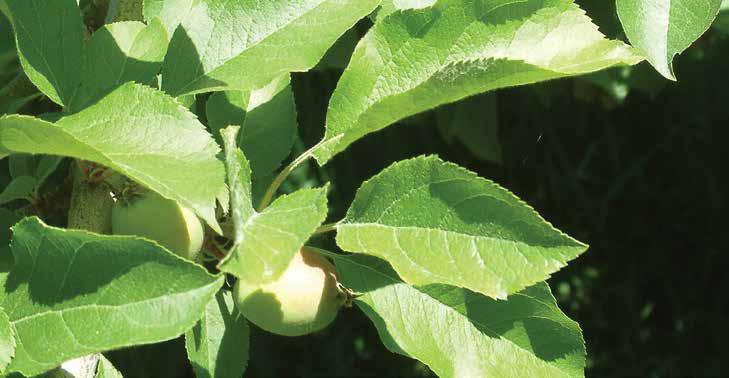
Setting up the orchard for next season.
Sarah McArley (née de Bruin) : AgFirst Consultants, written with reference to the archive of John Wilton’s articles for The Orchardist
Prior to harvest is a high stress time for a fruit tree, with a heavy crop load ready to pick. Thus the orchard fertiliser programme in the post-harvest period is a critical time for nutrient uptake to help replenish trees prior to senescence.
John Wilton wrote numerous articles at this time of year regarding the importance of post-harvest nutrition to set the trees up for the next season. He explained in his March 2016 article that “trees experience a major root flush once the crop is off, and this is the time when much of next season’s nutrient requirement is taken up.” In March 2013 John also wrote “it is very important for the tree to go into dormancy with adequate nitrogen reserves, because the spring growth flush and nitrogen requirements for fruit set are largely supplied from mobilised reserves already in the plant.”
Thus, as John continuously reminded growers at this time of year, ensuring the adequate levels of stored reserves are within the trees’ tissues ready for spring is hugely important to drive spring growth, maintain leaf health and set next year’s crop. He also noted that this should particularly be a consideration where blocks may be overcropped, as heavily cropped trees will be less able to replenish nutrient levels, particularly nitrogen.
With this in mind, what actions should growers be taking to ensure the trees go into dormancy well prepared? As you walk your blocks during harvest, be sure to take note of foliage colour, tree health, areas of poor growth or any fruit colour problems. This information, coupled with a leaf sample analysis to verify the current nutrient situation, will allow the post-harvest nutrition programme to be tailored to the individual needs of each block, and ensure the trees are then set up well for the next season.
To back up visual observations identified while walking blocks, throughout his articles John endorses targeted testing of nutrient and mineral levels of leaves and soils to identify specific fertiliser needs. Targeted soil and fertiliser management can improve within orchard row tree to tree variability by improving tree vigour in weaker growing areas, and can improve overall orchard performance as a result.
Ensuring the adequate levels of stored reserves are within the trees’ tissues ready for spring is hugely important to drive spring growth
Leaf testing in late January to guide post-harvest nutrient requirements is a very useful tool, especially as the leaf analysis cost relative to the value of the crop is so small. John noted that soil mineral levels do not change rapidly, so it is not necessary to test the same blocks on an annual basis, and that once every two or three years is often enough – unless there is need for significant pH (alkalinity/ acidity) or nutrient correction. Adding organic matter and available nitrogen to the basic soil profile test suite is helpful to improve the testing value.
Nitrogen and boron are nutrients key to the post-harvest period, and John noted that although the importance of postharvest application timing of other nutrients is less clear, any chronic deficiencies would warrant necessary applications.
For example, magnesium is highly mobile in leaf tissue and translocates readily from older leaves to actively growing new leaves and developing seeds. Additionally, John wondered if the magnesium deficiency problems are often due to excess soil potassium levels, or poor drainage. Therefore, he noted that foliar applications of magnesium over the growing season may be a more effective way to deal with magnesium deficiency, except in extreme cases of deficiency in the soil reserves where a magnesium soil fertiliser would be required.
Zinc is a nutrient readily taken up by buds and bark, so John noted leaf fall or dormancy as recognised timings for applying zinc. This should be guided by testing to show any deficiencies.
Nitrogen has a vital role in plant growth and development, as it is an essential component of chlorophyll, as well as being a major component in protein synthesis, cell division and therefore plant growth, flowering and fruit set. This nutrient is very mobile and is readily stored in the fruit buds and bark over winter, therefore growers should ensure there are adequate nitrogen reserves in the buds to kick off next year’s growth flush and set a full crop.
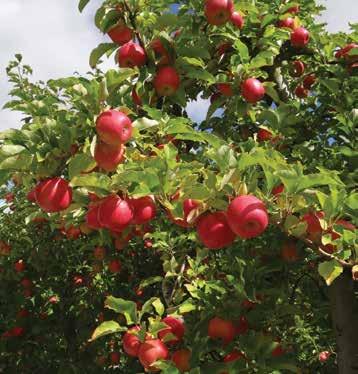
are lifted
John noted that “foliar uptake of nitrogen is considerably more efficient than soil application, and where nitrogen levels are more marginal, foliar applied nitrogen is readily translated out of the leaf before leaf fall, into buds and bark.” Thus, be sure to apply post-harvest nitrogen prior to leaf fall, to enable foliar uptake to occur.
Note: Foliar N applications are most effective in directly raising nitrogen concentrations in the floral bud. However, caution is advised since leaf scar susceptibility to European Canker infection can increase six-fold when foliar nitrogen is applied during the leaf fall period. So, the timing of application is crucial. Post-harvest foliar nitrogen must only be applied immediately post-harvest and well prior to leaf fall starting.
When walking your blocks, a variation in colour development can be indicative of fruit nitrogen levels. John explained in his March 2018 article “good colour [indicates] where nitrogen levels are low, poorer colour [indicates] where nitrogen levels are higher.” John also pointed out within this article that the “time of leaf fall and intensity of pre-leaf fall autumn colour can also be indicative of nitrogen levels. Low nitrogen areas drop leaves earlier and have high autumn colour, whereas high nitrogen areas drop leaves later, and leaves tend to have poor autumn colour development.”
Soil conditions can also be indicators of nitrogen soil reserves and availability. In that same March 2016 article, John explained that for a good soil during a dry season, a buildup of soluble mineralised nitrogen will become available once the soil becomes moist enough for root activity.
For blocks where this is the case, there may be adequate available nitrogen within the soil and so a heavy application of fertiliser nitrogen may not be necessary. However, in light, sandy soils with low organic matter levels, soil nitrogen availability will be lower, thus there is more of a need for nitrogen fertiliser to be applied to soils for root uptake. As many of our orchard soils are variable in texture and topsoil depth, there will be a variation in soluble mineralised nitrogen availability, which further reinforces the importance of targeted testing.
In the interests of high colour fruit production, growers must run levels of nitrogen to the lower end of the optimal range prior to harvest. If mid to late season nitrogen supply is high, fruit colour development can be suppressed, and fruit maturity at harvest and therefore storage ability may be compromised. Consequently, understanding soil and foliar nitrogen levels enables growers to strike a balance between good fruit outcomes and nutrient requirements to support next season’s growth.
This trace element is important for cell wall synthesis and has a role in increasing pollen tube growth and pollen germination. Boron therefore plays an important role in flowering, fruit set and fruit development.
John noted in his March 2011 article that “post-harvest foliar boron is readily taken up by foliage and translocated out of the leaves prior to leaf fall”. Thus, he recommends a post-harvest foliar boron application where boron is below the optimal range within a leaf test.

Feijoa Growers Association Inc 2025 Commodity Levy Rate
NZ Feijoa Growers Association Inc advises that the rate for the Feijoa commodity levy in 2025 remains at 3% of the price of feijoas sold in New Zealand at the first point of sale, or 3% of the fob value for export feijoas, or 3% of the unprocessed value of feijoas if a grower processes the feijoas on their own account. All prices are exclusive of GST.
The 2024 Annual General Meeting of the Association voted to keep the levy rate at the same level as the previous year.
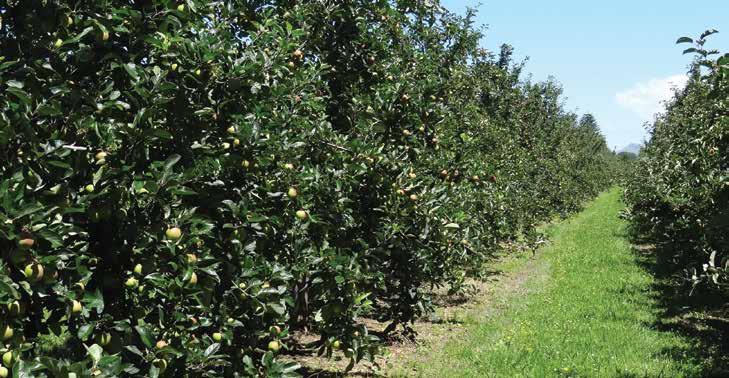
Crop load prior to harvest has an impact on the nutrient levels within the tree tissues going into dormancy, and although this can depend on the variety, nutrient loss through crop removal should be considered within a block specific nutrient budget. Nutrient reserves are depleted by heavy crop loads, as the crop takes the photosynthate which would have otherwise been directed to the roots, and as a result, weakens the autumn root growth flush. Generally, the greater the crop load, the higher the nutrient removal rate. John noted in March 2011 that “heavier crops drag a lot of potassium out of the system, [and therefore] potassium tissue levels are strongly influenced by crop load.” Thus, be sure to monitor heavily cropped blocks closely, to ensure the post-harvest programme matches the crop removal and then next season’s demand.
Another aspect to consider within a post-harvest programme is the ratio of nutrients within the block, as excessive levels of one nutrient may suppress another. John uses the example of the potassium and nitrogen ratio, and the link to poor fruit colour development in scenarios where this ratio is out of balance. In an orchard where nitrogen may be excessive, he suggested that elevating potassium levels be considered to overcome the colour suppression caused by high nitrogen status.
He also discussed the potassium and magnesium ratio in his March 2016 article, where he noted that as “many of our orchard soils are low in magnesium, we need to be careful not to increase magnesium deficiency problems by applying excess potassium fertiliser.” However, some Nelson soils are low in potassium levels, and therefore this will need attention. Again, John strongly endorsed leaf and soil testing to understand these nutrient balances and help identify where imbalances may need to be addressed.
In his March 2011 article for The Orchardist, John stated “one of the keys to high orchard performance is a healthy root system.” Then in 2013, he again outlined the importance of root growth for nutrient uptake post-harvest. This is still particularly relevant in the current 2025 season, as ongoing recovery from the flooded and saturated soils of the previous few seasons means some blocks are still not at optimal levels of root health, and therefore root growth.
Consequently, tree growth and development will be abnormal where these root systems are still in recovery, or where Phytophthora damage has compromised root systems. Applications of phosphoric acid can help to protect trees against Phytophthora and other root rots, and is the most effective on leaves in good condition (i.e. prior to leaf fall). If you think a particular block would benefit from a post-harvest application, check with your spray rep and marketing company regarding market considerations of residue levels.

Last year almost all of the
The end of large-scale growing of process tomatoes in Gisborne marks the end of an era – for now, at least – and growers say investment is needed to help the region meet its full potential
The horticultural landscape in Gisborne has again suffered a seismic shift with large-scale growing of outdoor tomatoes now firmly off the menu.
Once a shining star of the region, the industry was already under pressure with challenging seasons in the two years before the devastation of Cyclone Gabrielle in 2023.
Kristine Walsh
Before then – in 2021 – Gisborne-based processor Cedenco Foods was taking 15,000 tonnes of tomatoes a good amount but significantly down on the 22,000 tonnes processed in 2020, itself a decline from the 26,000 tonnes reported for 2018.
Local grower Judco Ltd was taking care of around 80 percent of production, with experienced grower Calvin Gedye (Gedye Brothers) producing the rest. But after catastrophic and repeated rain events both had crop losses in 2022 – up to 40 percent for the Gedyes and around half that for Judco.
Judco tried for a 2023 harvest but continuing weather events, punctuated by February’s Cyclone Gabrielle, led to more losses. And with Cedenco stopping tomato processing in the 2024 season, then again this year, the growing of process tomatoes in the region has come to an end.
PROCESSED TOMATOES WHOLE OR IN PIECES
Quantities of imported whole (or in pieces) processed tomatoes, mostly from Italy, has remained relatively stable since 2011.
Source: Stats NZ
PROCESSED TOMATO PASTE, PUREE, JUICE AND OTHERS
The rise in highly-processed imported tomatoes – puree, paste, juice and the like – since 2022 resulted in a record 16,000 tonnes imported last year – mostly from the world’s two largest producers: China and California.
Source: Stats NZ
Despite the setbacks however, Judco and Gedye Brothers have pressed forward, and both still grow lines like sweetcorn and squash for Cedenco. Judco has now doubled the 500ha of cropping it managed in 2022 – with a focus on squash, seed maize, maize and corn – while Calvin Gedye says he has redirected his energy and machinery to contractgrowing product lines like potatoes and fresh vegetables.
As for tomato growing in the region, the figures tell the story: Gisborne District Council’s 2020–2021 Summer Crop Survey recorded 134.9ha of tomato plantings in the region; the next year it had dropped to 120.6; and in the last available survey (2023–2024) it had plummeted to just 9.2ha.
Gedye Brothers’ retail business, The Tasty Vege Co., still produces small quantities of the Roma field tomatoes so coveted by locals, but Calvin says growing for processors – even those just up the road in Hawke’s Bay, where the anticipated processing at Heinz Wattie’s of 39,000 tonnes of tomatoes in 2025 – just doesn’t add up.
In addition to weather challenges, he says, the returns don’t justify paying the cost of transport.
“There is a lot of importation of products like tomatoes,” he says, “and if you see cans of them on the supermarket shelves for between one and two dollars, you don’t have to be a genius to do the maths.”
It’s not the first time Cedenco has pulled tomato processing from its Gisborne plant – in 1997 it moved the whole kit and caboodle to Australia, only to bring it back two years later.
But much like Gisborne’s commercial pea growing industry that folded in 2021, the most recent halt to process tomato growing in the region marks the end of an era.
Cedenco was formed in 1985 when the innovative Witters brothers – Cedric and Dean – responded to the withdrawal of Wattie’s from tomato growing by setting up their own processing plant, which opened the following year to much fanfare.
Over the years the company has undergone multiple changes to processing, product groups and ownership – it is now run by managing director Tim Chrisp for Imanaka Group (Japan), which bought it from receivers in 2010 – but until last year, tomatoes remained a big part of the business.
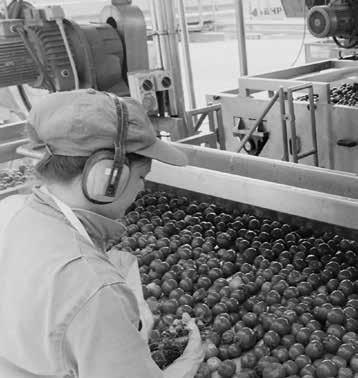
The Cedenco tomato line pictured in 1996, five years after the company had been bought by a consortium of local businesspeople, and three years after it listed on the stock exchange. Gisborne Herald file picture
Dean Davies is not himself a tomato grower but after 17 years as the Gisborne/East Coast regional representative for Process Vegetables NZ – a role Calvin Gedye took on when Dean stepped down last year – he has observed with some concern the changes taking place across the industry.
The root of some of that, he says, comes from outside the region, not the least being global influences in ownership of New Zealand-based vegetable processors and how they source their raw materials.
“That does put pressure on the industry, as they often import products from countries that can grow them more cheaply, so it really puts the squeeze on returns.
“All over the world there are wharves loaded with containers of produce that need to find a home, and oftentimes that home is here.”
Some of the changes, however, come from within Gisborne itself.
“Looking around the country it is quite eye-opening what can be achieved, like with the new frozen foods facility operated by Talley’s in Ashburton, which puts it on a huge growth path.
“We have this incredible horticultural industry in Gisborne and that sort of investment is just what we need to support it, but there doesn’t seem to be the will to spend the time and money.
“We have the land, we have the climate, we just need to see good investment so growers aren’t out here on a limb.”
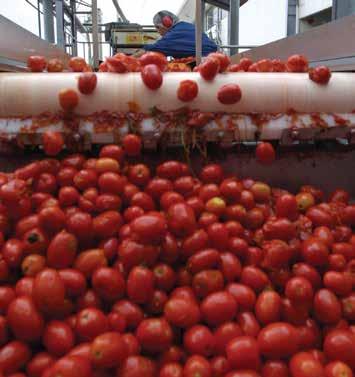
In 2001, California’s SK Foods bought into Cedenco, which eventually became a wholly-owned subsidiary. In 2010 the company was sold to its current owner, Japan’s Imanaka. Gisborne Herald file picture

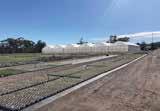
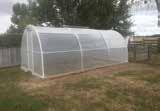
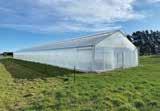

Earlier this year I was fortunate to attend the Oxford Farming Conference (OFC) 2025, the annual ‘start of the United Kingdom’s farming year’ event. And what a start it was!
Richard Palmer : Willisbrook Orchard managing director
A showcase of six ‘Inspiring Innovators’ certainly set the scene. The conference was exceedingly well organised and attended – and with high-calibre presenters. What impressed me most was both the exceptionally welcoming and open discussions, and the commitment to making UK’s farming part of the carbon-zero economy.
Just like in New Zealand, and elsewhere, farmers in the UK are doing it pretty tough. The recent changes to include farms in inheritance tax is seen as the final straw by many. I hadn’t fully appreciated the nature of the unwritten covenant between British famers and society, with the covenant of providing food as a societal good (and thereby exempting farmers from things like inheritance tax).
inflation, and now the inheritance tax, farmers were feeling down on their lot, and very disappointed with the new Labour government.

There is an increasing drive to support local –both from farmers and retailers – but the politics of cheap food and subsidies is clouding how this happens in reality.
Some farmers aren’t subsidised, so they are particularly exposed to the expectation of cheap food – a hangover of a deliberate post-war food policy
The European Union’s Common Agricultural Policy (CAP) had supported the idea of cheap food by subsidising farmers (I appreciate this is a somewhat simplistic view), but is now gone, replaced by other mechanisms in the post-Brexit era.
Many of these mechanisms have been very slow to be established, and when added to poor farm gate returns,
Of course, some farmers aren’t subsidised, so they are particularly exposed to the expectation of cheap food – a hangover of a deliberate post-war food policy and the EU CAP. The expectation of fair grower returns, and who should pay, is clearly an issue that the UK must grapple with, and somewhat urgently.
In light of that, one might have expected a navel-gazing, disheartened conference, but of course a good cup of tea always helps one to carry on!
The conference was full of debate, including substantial questions for the excellent speakers, including the Secretary of State for the Environment, Food and Rural Affairs (DEFRA) (equivalent to an Agriculture Minister).
More importantly, farmers debated with each other on topical issues, including the OFC Debate held at the famed Oxford Union, known to many New Zealanders for a legendary line from Prime Minister David Lange.
I thoroughly enjoyed a presentation on the possibilities of gene editing to improve animal welfare in pigs, in part because it solidified my thinking on the necessity of seizing this opportunity for New Zealand food and fibre production, as a means to stay competitive and to benefit the planet.
On the topic of environment, many excellent presentations covered the research and operations to reduce carbon emissions, including many showcases of circular economy operations. UK farmers are committed to this journey in both understanding the importance, and acting to reduce waste and emissions. To quote Ian Marshall from Queen’s University Belfast, “This is not about decarbonising agriculture. This is about agriculture decarbonising the economy”.
PIPFRUIT MARKET IN THE UK
Tonnes
ONION MARKET IN THE UK
UK domestic production Exporting countries to UK (excl. NZ)* NZ exports to UK
The volumes produced by the United Kingdom’s apple and onion growers fall a long way behind domestic demand, illustrating the challenges that local growers face. Sources: DEFRA and StatsNZ
After three years of trading with the United Kingdom (and a full year trading under the New Zealand-UK FTA), export figures are becoming more precise than when the country was part of the European Union’s cross-border movements of goods.
According to the latest New Zealand Horticulture Export Authority’s Barriers to our Export Trade report, apples
(35,221 tonnes) and onions (11,011 tonnes) account for almost all of New Zealand’s exports to the UK. Re-exports from the EU, such as kiwifruit, are harder to track. However, it seems the Brits have still not fully fallen in love with the kiwifruit, despite the huge volumes consumed in neighbouring European countries.
*Pipfruit: France, South Africa, Italy etc Onions: Ireland, Romania, The Netherlands etc
One small example was a craft brew pub and distillery experimenting with using their waste feedstock and heat to produce mushrooms to be used in their brew pub menu. It’s a simple but effective utilisation of the manufacturing by-products.
Time for social engagement is high on the priority of OFC. The experience of dining with 350 others in the wonderful Tudor Dining Hall at Christ Church College made for a great
evening of discussion, learning and friendship. No French duck in sight with a fabulous three courses featuring UK produce.
I must particularly thank Ali Capper, my host and the chair of British Apples & Pears for her generosity with her time, whilst meeting her many other responsibilities, including as an OFC Director.
ARE YOU A SUPPLIER TO THE MAJOR GROCERY RETAILERS? THE GROCERY DISPUTE RESOLUTION SCHEME ENABLES YOU TO ACCESS QUICK, COSTEFFECTIVE, PRIVATE AND CONFIDENTIAL RESOLUTION OF DISPUTES YOU MAY HAVE WITH THE REGULATED GROCERY RETAILS - UP TO THE VALUE OF $5 MILLION.
Find out more about the Grocery Dispute Resolution Scheme at www.grocerydispute.co.nz



Robinson is a Michelin-trained chef who grew up in Nelson

Vegetable consumption in New Zealand has reached concerning levels, with “less than 20 percent of New Zealanders eating the recommended amount per day,” according to Vegetables NZ chair John Murphy. To combat this trend, New Zealand vegetable growers have partnered with EATucation, a social enterprise focused on food education.
“EATucation’s programme will improve children’s attitudes towards vegetables and drive better health outcomes throughout their lives,” says John, noting that young participants will share their knowledge with their communities.
EATucation founder Matt Robinson emphasises the importance of food literacy: “We provide teachers with ready-made food education resources that connect to all aspects of the curriculum.” The initiative addresses declining vegetable consumption, which currently mirrors Australia’s low average of 1.7 serves daily.
For more information visit: www.freshvegetables.co.nz
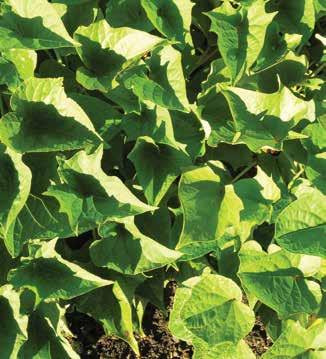
A pilot programme in Northland could reduce sediment loss and increase resilience
Horticulture New Zealand (HortNZ) and Kaipara Moana Remediation (KMR) are launching a pilot programme to build resilience in the Northland kūmara industry, focusing on waterway restoration and best management practices.
HortNZ chief executive Kate Scott says, “We identified an opportunity to establish a partnership with KMR as part of the Growing Change project workstreams. The KMR programme is designed to assist Northland primary sector landowners in the Kaipara Moana catchment in reducing sediment loss by up to 50 percent and restoring waterways.”
KMR Pou Tātaki Justine Daw says the programme will “support increased resilience to future climatic events such as floods, cyclones and storms, increase environmental stewardship and improve social cohesion and resilience across participating rural communities.” The initiative includes fencing, native planting, and soil management improvements.
For more information visit: www.hortnz.co.nz
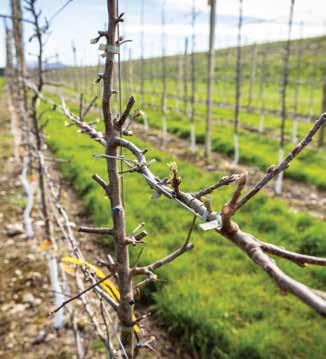
Investments in higher productivity and high-value varieties contributed to reaching the revenue milestone (Photo by Tony Benny)
New Zealand’s apple and pear industry has reached a milestone $1 billion in Orchard Gate Revenue, according to new economic data. Almost two years after Cyclone Gabrielle, the industry has achieved a total economic impact of $2.5 billion, marking a 27 percent increase from 2023, whilst employing over 13,500 people.
NZ Apples & Pears chief executive Karen Morrish says this season marks a return to form.
“With little change in planted area, increasing costs and yet a growth in our economic contribution, we can be confident that this has come from increased productivity, investment in high-value IP varieties and a diversification of international markets. Our industry is pulling sustainable levers to grow our contribution and NZ Apples & Pears wants to ensure a healthy operating environment that is conducive to prosperity remains.”
For more information visit: info.applesandpears.nz
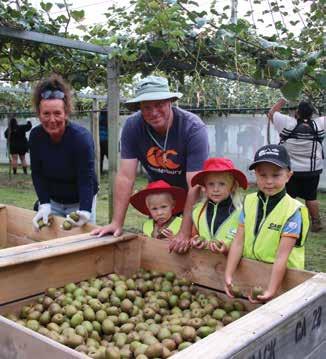
Pictured while pickers are hard at work are from left orchard manager Sarah Davidson, grower Mark Ruiter and his children

New Zealand’s 2025 kiwifruit harvest has kicked off, marking the country’s earliest ever harvest with the first fruit picked near Edgecumbe, Bay of Plenty, in early February.
The season begins with Zespri RubyRed™, followed by SunGold™ and Green kiwifruit. This year could see a milestone harvest exceeding 200 million trays, up from last year’s 190 million.
“While my thoughts are with those Tasman and Whakatāne growers who received significant hail damage last December, overall, growers have experienced a great lead up to harvest”, says NZKGI chief executive Colin Bond.
Edgecumbe growers Mark and Josie Ruiter and their orchard manager Sarah Davidson were excited to be the first in New Zealand to have the kiwifruit harvested this year.
For more information visit: www.nzkgi.org.nz
Dinah Cohen : TomatoesNZ general manager
A group of six representatives from Vegetables NZ and TomatoesNZ travelled to Berlin, Germany last month to attend Fruit Logistica, the largest horticulture supplier event in the world. I was lucky enough to be part of this group representing all greenhouse growers throughout New Zealand, although my particular focus was on gathering information that I could pass on to tomato growers. There were around 3000 exhibitors from over 90 countries. With over 70,000 visitors, it’s a big, bustling sprawling citysized event with the opportunity for lots of conversations and seeing products in action. The New Zealand greenhouse industry faces many challenges and for my conversations with international suppliers I was particularly interested in several key topics.
Disease management
With tomato brown rugose fruit virus (ToBRFV) common in Europe but still posing a threat for New Zealand growers, hygiene around the greenhouse plus growing resistant varieties are the best management a grower can have in place for when this virus arrives. That said, two Dutch growers I spoke to with over 30ha of tomatoes each, have chosen not to grow any resistant varieties yet, because they feel the risk posed by the virus is secondary to the risk of crop issues around yield, taste and general quality of the resistant varieties.
Instead, hygiene management at their properties is paramount and includes standard practices such as employee uniforms including shoes for workers, colour coded to days of the week, hand and shoe washing at every entrance point that cannot be bypassed, dipping of gloved hands and tools after each row. These measures were in addition to:
• no entry into the greenhouse for anyone who isn’t directly working the crop (including marketing and sales staff)
• operating a one-way system in their packhouse
• trucks coming onto the property are disinfected before being loaded and drivers wear PPE (personal protective equipment)
• owning, washing and disinfecting their own ‘closed loop’ crates which are kept out of the greenhouse.


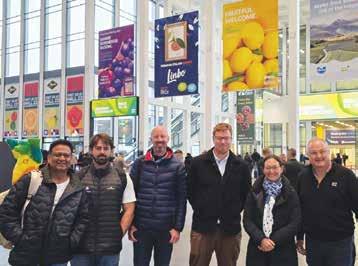
There are some impressive washing stations available and products for cleaning make some bold claims such as Huwa-San and the newer Virba-San from Roam Technology (similar products but Virba-San doesn’t contain silver). Both are available in New Zealand and are said to be as effective as Virkon but without its corrosive nature. See www.roamtechnology.com for more details.
With over 70,000 visitors, it’s a big, bustling sprawling city-sized event with the opportunity for lots of conversations and seeing products in action
Having said that, we were repeatedly told that once you have ToBRFV, it is impossible to get rid of it. In fact, one rep claimed that ToBRFV can lie dormant for years before resurfacing as an active virus. So back to hygiene and resistant seed varieties being the insurance policy that growers in other parts of the world are relying on.
Seed companies were all focused on promoting their ToBRFV resistant varieties. We tasted many of these during our time away. There were no standouts but quality including taste can differ according to the growing environment – and personal preference plays a part. The good news is that there are lots of resistant options for both large and small tomatoes, loose and truss, and the seed companies say that there is good availability of seeds. The best advice would be to order some small samples to trial in your greenhouse and see if you find a variety that works for you. Bear in mind that there is no standardisation for the level of resistance that the seeds have, so each company can essentially claim whatever they want. Some good questions to ask are what generation of resistance a variety is in, and whether it in fact has resistance to ToBRFV.
There are lots of biological controls on the European market. While registering a new to New Zealand beneficial insect would be an extremely lengthy process with no guarantee of success, there are some biological fungicides and insecticides that might have a slightly easier registration journey. Even though some of the bigger companies seemed to be a little dismissive of trying to
enter the comparatively small New Zealand market, others were interested in investigating the registration process. I will maintain contact and push for more tools for growers.
In terms of energy saving tech, I will cover this more next month as we saw several options during our visits and meetings in the Netherlands. However, alternatives to natural gas or coal were not widely represented – syngas was one option we talked to a supplier about. It is worth further investigation as inputs can be much broader than for a biomass boiler (e.g. straw and plant material). As well as heating water, the output also produces high density CO2 which can be fed back into the greenhouse for improved yields. One provider operating out of Australia is Optimal Group: optimalgroup.com.au/renewable-gas
If you have any questions about anything fresh tomato related, please don’t hesitate to contact me: dinah.cohen@tomatoesnz.co.nz
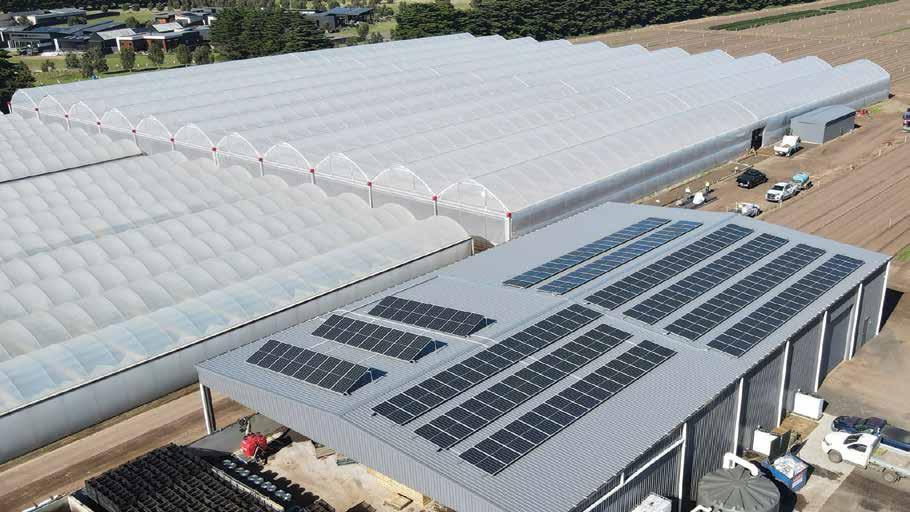

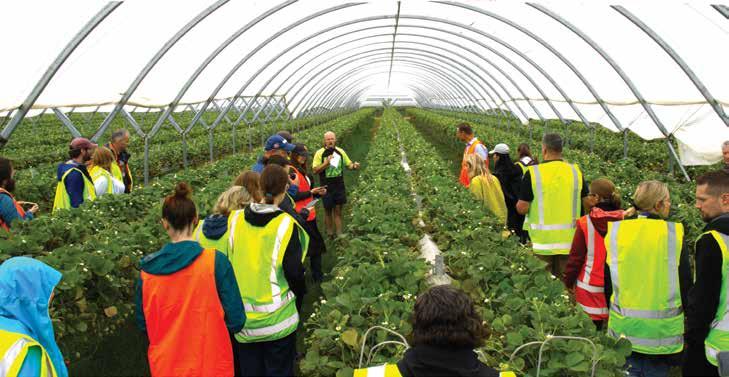
…than to hear about it a thousand times, as the expression goes. For the second year, Horticulture New Zealand has taken a proactive role to facilitate greater cross-pollination between industry and government.
On a rainy Wellington day in February almost 40 central and local government staff jumped on a bus to visit growers in the Horowhenua district.
NZGrower & Orchardist staff
The field trip was the second annual cross-pollination day, which aims to give government staff involved in horticulture a chance to hear directly from growers about their operating environment, views, concerns and ideas.
Organised as part of the Aotearoa Horticulture Action Plan, the bus travelled north to Watson’s Garden, Lewis Farms and Woodhaven Gardens.
The participants came from the Ministry for Primary Industries (MPI), Biosecurity New Zealand,
Ministry for Business, Innovation and Employment, Environmental Protection Authority (EPA), Plant & Food Research and Horizons Regional Council.
“I found the trip very beneficial,” says Ailsa Conn, senior advisor, plant exports at Biosecurity New Zealand (which is part of MPI). “The opportunity to see how our primary producers operate helps build a practical understanding of where policy fits, and challenges industry faces. I would highly recommend this trip to anyone in horticulture policy.”
EPA reassessments acting team leader Rebecca Isaacs was one of several EPA staff to attend this year’s event.
“This was my first time attending one of the crosspollination events and it was a cool opportunity for industry and government agencies to connect faceto-face and share our perspectives.”
David Wilson, specialist advisor for industry growth at Ministry for Primary Industries, works on the Sustainable Food and Fibre Futures (SFFF).
“First-hand experience of, and insight into, a grower’s world is valuable context when assessing funding applications for innovations that address sector problems and opportunities,” David says.
This was a cool opportunity for industry and government agencies to connect face-to-face and share our perspectives
Matt Thorn, who is the regional representative – lower North & upper South Island for the Aotearoa Horticulture Action Plan, says the event this year was organised following the great feedback from both growers and government staff after the first event last year.
“We recognise that it is often difficult for government staff to travel to meet with those whom their policies and regulations directly affect,” Matt says. “We’re grateful to the participants as well as the growers who gave up their time to make the day a success.”
Launched in 2023, the Aotearoa Horticulture Action Plan was developed collectively, with input from industry, government, Māori and research providers. The plan belongs to everyone involved in the New Zealand horticulture sector.
The Aotearoa Horticulture Action Plan provides a guiding compass to achieve the ambitious goal of doubling the farmgate value of horticultural production by 2035 in a way that improves prosperity and protects our environment.
First-hand experience of, and insight into, a grower’s world is valuable context when assessing funding applications for innovations
Due to the proximity to Wellington, the three growers visited are all in the domestic fresh produce sector, however this provided an excellent focus on the urgent changes needed in resource management reform to make growing fresh, healthy vegetables for New Zealanders a permitted activity.
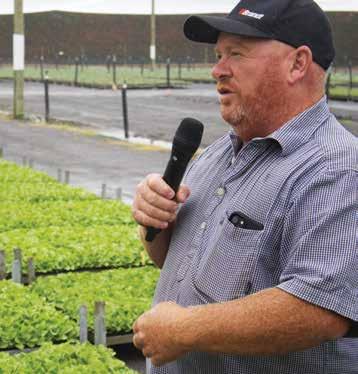

Proudly owned and operated by the Stocker family Over 40 years’ experience in hydroponic sytems
Hydroponic supplies and advice
Custom blended Fertilisers and Nutrients
Irrigation / Fertigation equipment
· Greenhouse Automation
Commercial and Hobby supplies
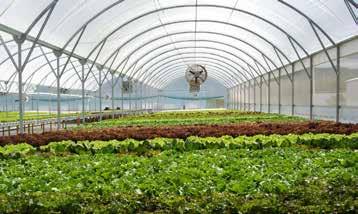
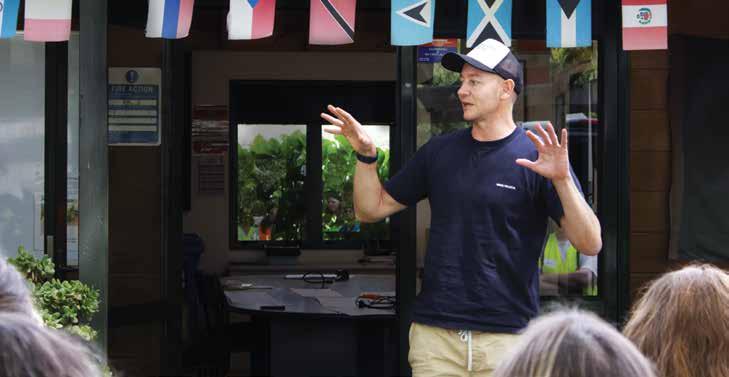
Jay Clarke at Woodhaven Gardens in Levin: “For growers, the goal is the same across the country: to provide Kiwis with healthy, fresh vegetables, grown in a sustainable manner, at a reasonable price”
“The field trip provided useful exposure to the industry and generated some excellent, robust discussions,” Matt says.

Watson’s Garden in Ōtaki was a new stop this year. The commercial nursery is a key supplier for New Zealand’s vegetable sector.
Further north past Levin at Lewis Farms, participants learned about the challenges of growing strawberries in tunnel houses – a way of growing that is common overseas but rare in New Zealand. Participants also learned about the evolution of the asparagus industry since it first started in New Zealand the 1980s.
The field trip provided useful exposure to the industry and generated some excellent, robust discussions
Jay Clarke, of Woodhaven Gardens in Levin, told participants it’s time that people saw vegetables as “health on the shelf, not cost on the shelf”.
“The country should be celebrating the incredible efficiency of the industry both environmentally and operationally, and the crucial role it plays in the domestic food supply.”

NZGrower & Orchardist staff
The early part of the 2024 to 2025 process vegetables season was the most challenging in a number of years for growers of peas and beans.
“Like rugby, it was a season of two halves,” says Matt Thorn, business manager for Process Vegetables NZ. “I recently visited growers in Canterbury and heard about how it had been a difficult first half of the season because of the extreme lack of rain before Christmas.
“Conditions were very challenging. When there is not enough water the crops mature faster. Process peas are usually harvested three months from planting. The major processers have pea harvesters running 24/7, so there is no room for adjustment in the schedule.
“There is a very limited window of days to harvest peas once they are ready. Before Christmas they were maturing very fast so it was very hard to match the peas that were ready with the harvest schedule.
“However, the New Year saw abundant rainfall and we went from dust storms and desert to very good tonnage coming through for process growers.”
Simon Abel, field and agronomy manager for Talley’s in Canterbury, said crop establishment had been strong with warm and favourable planting conditions. However, as spring moved into summer the Ashburton region had its third driest November on record, with only 14mm of rain. As crops moved into December, consistent Nor‘west winds also moved crop development along swiftly.
“Crop matured rapidly, with harvest and processing efforts moving into overdrive to get our hands around most of the crop,” said Simon. “Processing efforts doubled, with the entire factory team focusing on production lines and squeezing every last bit of capacity out of the line.
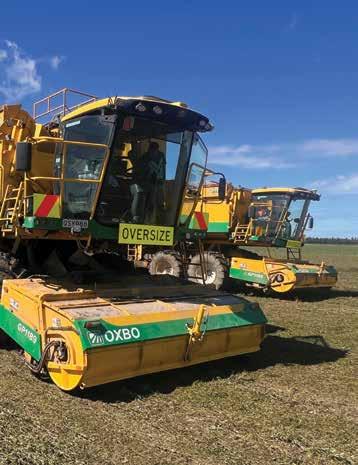
“Once we hit Boxing Day, the weather patterns turned to a more La Niña dominated system. This resulted in cooler temperatures, and good rainfalls. The weather slowed crop development.
“The pea season overall has been challenging but rewarding. Results have been strong, with good quality peas being harvested. We would like to thank all our growers for their continued support as we expand processing capabilities in the new season.”

Antony Heywood : Vegetables NZ chief executive
Question – how do you sell a good idea? If I knew this, I wouldn’t be writing to tell you about it, as I would have retired as a marketing mogul on a secluded tropical beach.
But what I have understood in the past couple of years is the power of partnerships. In particular, using the power of co-design during prototyping to advance the concept to a point where it is grower-centric, and delivering grower outcomes. This is the perfect win:win scenario.
GOVOR is the ‘little engine that could’. The lightweight electric tractor was developed by local start-up, Agovor (notably with a little help from the recently disestablished Callaghan Innovation).
GOVOR is not much to look at but does the job. It’s designed to automate outdoor manual labour tasks for row-based growers. Autonomous units don’t need to be the size of a tank, nor as heavy, but they do need to do the job. Key considerations must be more than task efficiency. Today, any capital outlay should consider all the capitals – financial, environment, social and cultural. Think energy conversion, think soil compaction, think climate change, and think a new clean solution to manage the task.
Richard Beaumont is the director at Ardmore Nurseries and founder/ director of New Zealand start-up Agovor. During last month’s Vegetables Big Day Out in Pukekohe, he demonstrated GOVOR, a powerful lightweight electric tractor designed to automate outdoor manual labour tasks for row-based growers.
A range of attachments can be used like mowers or sprayers.

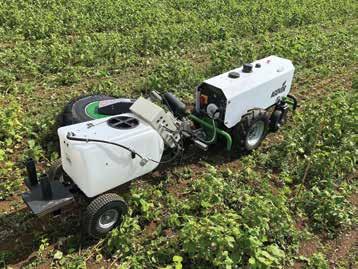
As a grower once said to me: “we don’t need to be bleeding edge but we do need to incorporate technology at an early stage so it can fit into our current systems”.
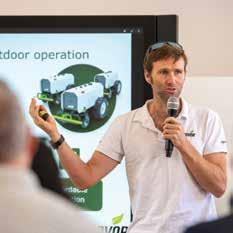
A camera allows troubleshooting via a cellphone even when you’re offsite. Being GPS-plotted the GOVOR is great to run at night, getting jobs done when staff are usually at home.
“If you’ve got one or multiple machines running around at 2.5km per hour there are no lunch breaks,” Richard says. “It’s a real paradigm shift in how you think about how you operate.”
Back to Agrovor: The model shown in the photo is set up for weed spraying that we had on show during the Vegetables Big Day Out last month. GOVOR could also be set up for laser weeding or fruit counting. That is, any task to deliver function at a low cost and energy. It could even qualify for a green loan.
Whatever the task, embedding new technology into current systems takes time. If new tech is not part of BAU, its value can never be truly developed or full potential attained.
A good start is to set the tech up as a project with a project brief and milestones. This gives all parts of the project a clear scope and expectation. It also enables results to be considered on their merit rather than qualitative metrics alone.
The other consideration for ‘NZ Inc’, and back to my earlier point on partnerships, New Zealand tech companies must

Saturn
A new early red to complement our range. Red Saturn matures 7-10 days earlier than Red Planet. Sow mid April to mid May only. Excellent colour and shape with good internal colour.

Versatile for sowing December to May. Medium-deep drumhead shape. Excellent internal quality and field holding. Harvest early winter to spring, dependent on location.
form partnerships with growers to advance the prototype towards commercialisation. Growers have a big part to play in getting any new tech fit for purpose. The importance of this partnership is based on the following opportunities: Products set up for New Zealand conditions
Service is on hand
Grower centric outputs
Pipeline activity for future development
System evolution to adopt technology
Resilience systems for climate change
Monitoring and measuring are being incorporated into data sets
Global connections and networks are fostered for complementary activity
New Zealand is a small country at the bottom of the world. It is isolated if we want it to be. The flip side to this is that we are an advanced primary industry economy, set up for working with Northern Hemisphere partners in counterseasonal activity to advance global technologies. It all comes back to perspective. What do you want to be, conservative and content, or connected and competitive?
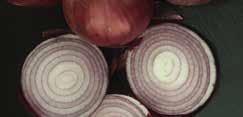
Market leading early overwintering red onion. Sow mid April to mid May & harvest Nov to early Dec dependent on location. Excellent colour, shape and vigour producing excellent yields.

Dense fresh market/process cabbage with a short core and good weight. Good disease tolerance and a nice deep green colour. Harvest winter/spring. Excellent holding ability sizing.
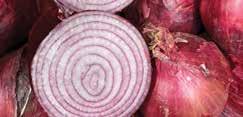
Overwintering short day. Excellent internal red coloured rings. Uniform medium size and slightly more globe shaped than Red Planet. Surprisingly firm with 2 good skins.
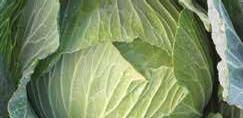
Fuyu Midori
Industry benchmark. Deep drumhead shape with dark green leaves and heavy structure. Very adaptable variety. True winter type with strong similarity to Wintercross.
Kate Trufitt : Potatoes NZ chief executive
How do you take your coffee?
With potatoes? Potato milk is an increasingly popular option for a growing number of consumers in Sweden, China, the United Kingdom and other parts of Europe, thanks to the development of DUG – a veganfriendly potato-based milk.
First developed in 2017, DUG is a Swedish brand that stems from research undertaken by Professor Eva Tornberg at Lund University. Its major selling points are that it is creamy (due to emulsion technology), has a low climate footprint – with potatoes requiring significantly less water than almond or cow’s milk for example – and can be used just like any other milk.
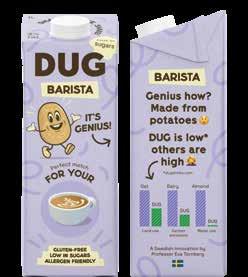
So why does it matter that a portion of the world’s population are drinking their lattes and eating their cereal with potato milk? Because it is a successful example of the power of innovating and creating value-added products from potatoes.
Value-added products from potatoes create a way for our industry to diversify its income streams, reduce reliance on fluctuating demand and prices of raw products, and access new markets and opportunities for growth.
Potato milk is just one of multiple value-added potato products currently being produced or developed in global markets.

‘Potato plastic’ is a biodegradable bioplastic material made of potato starch. The idea is that it could be used for short shelf-life products, such as takeaway cutlery and straws, and could then decompose to become nutrients for the soil in two to three months. Prototypes have been made, but there has been no mass production to date.
Potato starch is already in use as a special starch-based adhesive for paper products. Synthetic glues, which have been commonly used in paper packaging, are made from polymers that do not break down naturally, contributing to environmental pollution, but the potato starch-based alternative has been shown to be 94 percent biodegradable within 14 days. The other plus side for this innovation is that potato starch is a by-product of French fry and potato crisp production, so that makes it a sustainability win for the paper products industry and the food industry.
Potatoes are also being used to make vodka by producers, including Chopin Vodka, and by some food producers to make a healthier high-fibre ice cream.
As a food staple, potatoes are already a globally important, efficient crop that makes a major contribution to people’s diet and nutrition around the world. Creating value-added products is not about changing the existing vital role of the potato, but it is about considering what other opportunities exist to use potatoes and potato by-products.
New Zealand has a successful, mature potato industry and there is an opportunity to foster greater collaboration amongst our growers, stakeholders, experts and scientists to focus on opportunities to innovate and develop valueadded products that will help grow our industry success and sustainability in decades to come.
Genesis Nurseries, a leading provider of quality nursery stock in New Zealand, has announced the appointment of Chris Hurrey as its new Head of Operations.
This exciting development signals a bold step forward for the company as it continues to strengthen its position in the nursery industry.
Chris Hurrey is no stranger to the horticultural world, particularly in the Hawke’s Bay region, where he has spent 31 years cultivating a reputation for excellence. With an extensive background in both the nursery and orchard sectors, Chris brings a wealth of knowledge and hands-on experience to his new role. His understanding of plant propagation, orchard management, and operational efficiency makes him an invaluable asset to Genesis Nurseries.

“I look forward to driving new innovation and growth”
Born and raised in Hawke’s Bay, Chris has always been deeply connected to the region’s horticultural roots. He began his career working in local orchards, where he honed his skills in orchard maintenance, harvest logistics and crop quality assurance. Recognising the importance of plant health from the ground up, he transitioned into the nursery sector, where he focused on the propagation of high-performing fruit trees and plants tailored to New Zealand’s unique growing conditions.
Hawke’s Bay has always been home for me, and I look forward to driving innovation and growth right here in our community”
Throughout his career, Chris has been a strong advocate for sustainable practices. His work has emphasised the importance of soil health, water conservation and pest management, aligning perfectly with Genesis Nurseries’ commitment to environmental stewardship. His leadership style is characterised by a hands-on approach, ensuring that teams are well-supported and that operations run smoothly from the nursery to the customer.
thrilled to join Genesis Nurseries,” Chris said in a recent statement. “The nursery industry plays a vital role in shaping the future of horticulture in New Zealand, and I’m excited to contribute to that legacy. Hawke’s Bay has always been home for me, and I look forward to driving innovation and growth right here in our community.”
Under Chris’s leadership, Genesis Nurseries is poised to expand its offerings while maintaining the exceptional quality that customers have come to expect. His appointment is a testament to the company’s focus on investing in experienced professionals who understand both the science and business of horticulture.
As Genesis Nurseries looks to the future, Chris Hurrey’s expertise will undoubtedly be a cornerstone of its success. His passion for the industry, combined with his deep roots in the Hawke’s Bay community, promises to bring fresh perspectives and renewed energy to the nursery’s operations. This appointment not only highlights Chris’s remarkable career but also reflects Genesis Nurseries’ commitment to leading the way in New Zealand’s horticultural sector.
With the budding window closing soon, now is the time to secure your orders. Genesis Nurseries works with professional budders to ensure the best possible results. If you have budding needs, give Chris a call for a chat about how Genesis Nurseries can help.
GNL enabling growers to be world leading. To contact Chris, call 0800 472 383



